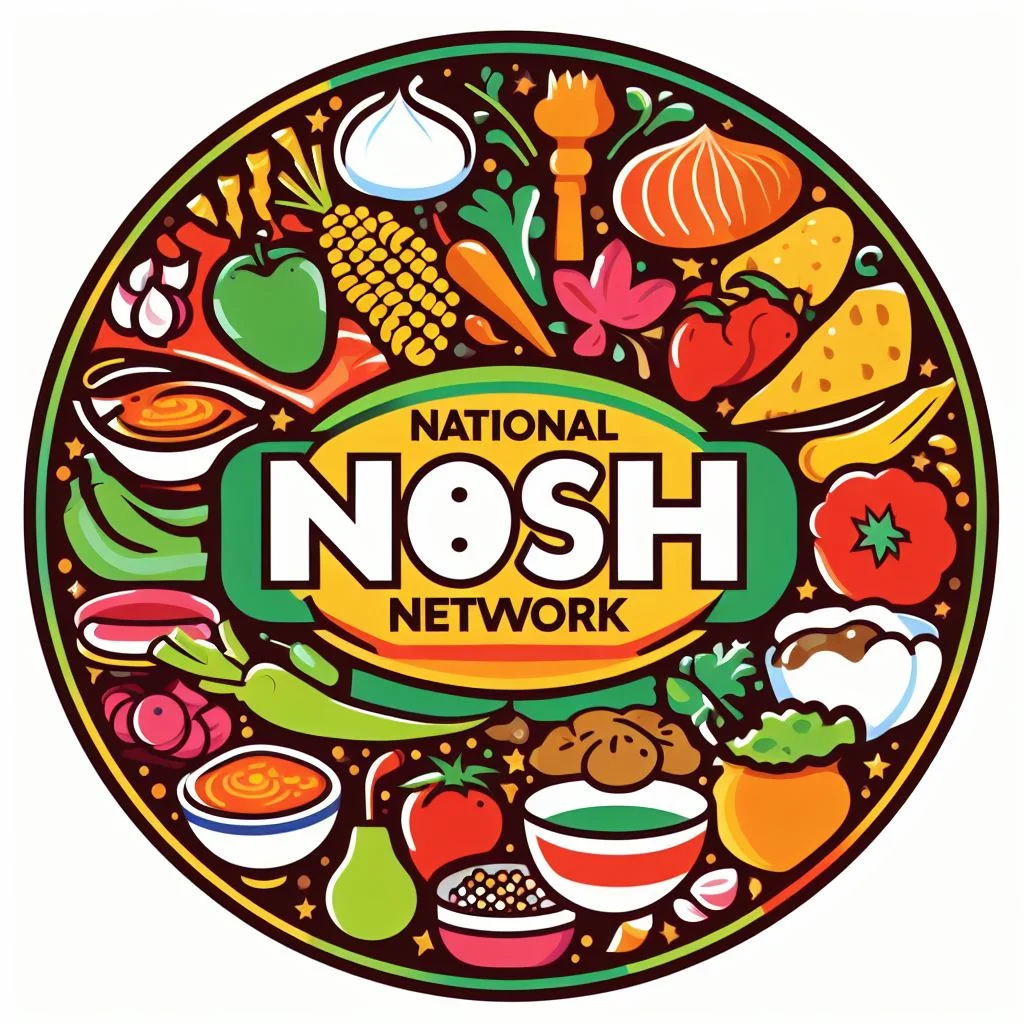Take Me to the Recipes
Imagine a land where volcanic mountains cradle lush rainforests, and the Atlantic Ocean whispers secrets to sandy beaches. This is Cameroon, a country blessed with breathtaking diversity that extends far beyond its landscapes. Cameroon food is a captivating reflection of this vibrant tapestry, a symphony of flavors influenced by history, geography, and a deep connection to the land.
Embark on a delicious adventure as we explore how Cameroon’s unique location has shaped its culinary identity. Spicy stews simmering in the volcanic highlands whisper tales of ancient trade routes, while fresh seafood dishes served along the coast carry the whispers of the Atlantic breeze. French colonial influences mingle with indigenous cooking techniques, creating a unique fusion that tantalizes the taste buds.
Prepare to delve into a world of bold flavors: fiery stews infused with chilies and ndombo (a local spice mix), plantains cooked to sweet perfection, and an abundance of fresh ingredients harvested from fertile volcanic soils. This isn’t just a journey through recipes; it’s a captivating story waiting to be savored, bite by delicious bite.
Take Me to the Recipes
Key Takeaways
Diverse Geography
Cameroon boasts diverse geographical features including rainforests, savannas, mountains, and coastal plains, offering a rich landscape for exploration and biodiversity.
Colonial Legacy
With a complex history of colonization by both Germany and France, Cameroon’s cultural landscape reflects a blend of European and indigenous influences, evident in its language, cuisine, and societal norms.
Cultural Diversity
Home to over 200 different ethnic groups, Cameroon is a melting pot of cultures, languages, and traditions, contributing to its vibrant and dynamic societal fabric.
Tropical Climate
Positioned near the equator, Cameroon experiences a predominantly tropical climate characterized by high temperatures, humidity, and distinct wet and dry seasons, influencing agricultural practices and cuisine.
Rich Culinary Heritage
Cameroonian cuisine is renowned for its diversity and flavors, with staple ingredients like plantains, cassava, yams, and various meats and seafood reflecting the country’s agricultural abundance and cultural influences.
Spice Trade Influence
Historically, Cameroon’s position along the ancient spice trade routes facilitated the exchange of culinary techniques and ingredients, leading to a fusion of flavors in its traditional dishes.
Traditional Practices
Traditional farming methods, such as slash-and-burn agriculture, have long been practiced in Cameroon, shaping not only the landscape but also influencing culinary traditions and food production techniques.
Influence of Migration
Migration within and outside of Cameroon has played a significant role in shaping the country’s culinary landscape, with influences from neighboring West African countries.
Where is Cameroon?

Cameroon, officially the Republic of Cameroon, is a country in Central Africa. It shares boundaries with Nigeria to the west and north, Chad to the northeast, the Central African Republic to the east, and Equatorial Guinea, Gabon and the Republic of the Congo to the south.
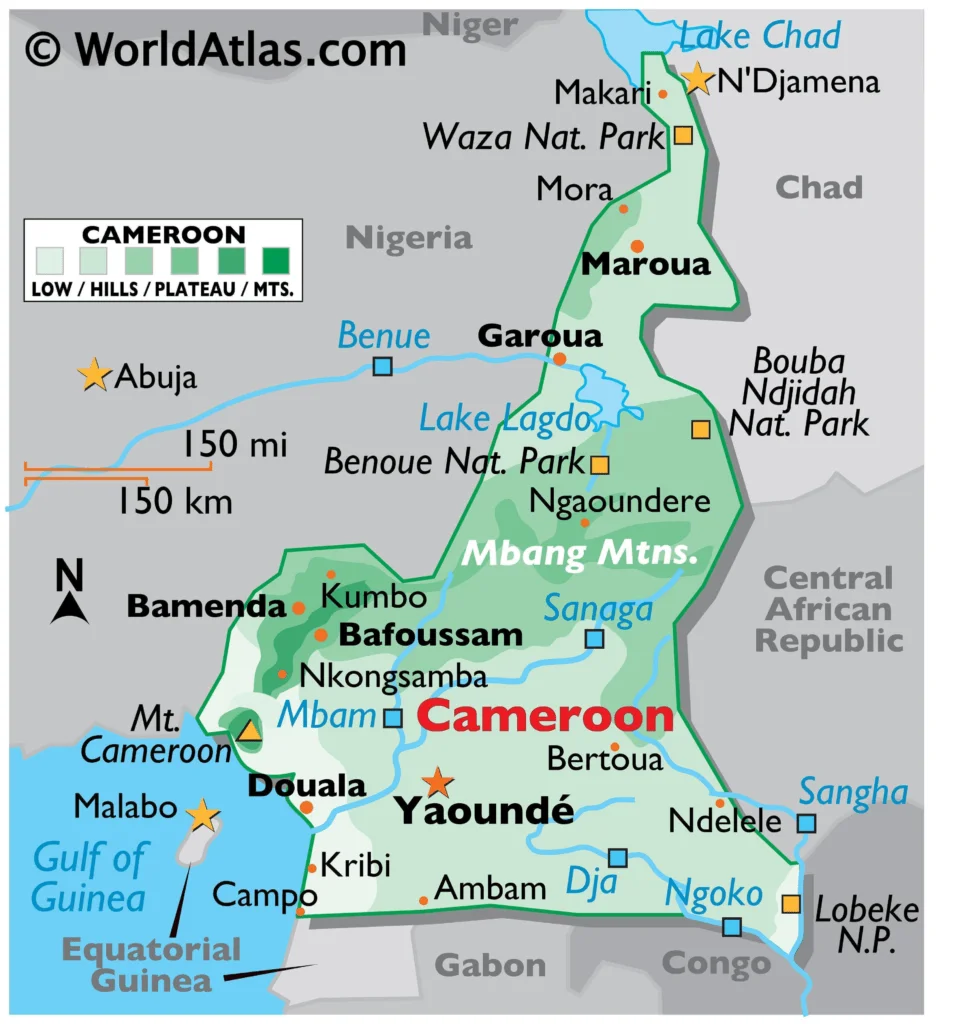
Index to the Contents
- Take Me to the Recipes
- More articles
- 10 Interesting Facts about Cameroon
- Cameroon’s History and the Effect It Has Had on the Cuisine
- How the Cameroon Climate and Geography has Influenced the Cuisine
- Understanding the Essence of Cameroon’s Cuisine
- Exploring Cameroon’s Ingredients: The Flavors of Cameroon’s Cuisine
- Cameroon’s National Food
- Exploring Cameroon’s Street Food
- The Most Popular Cameroon Recipes
- How Healthy is Cameroon’s Food?
- Cameroon’s Cuisine Recipes to Try at Home
- Conclusion
- FAQ’s
More Articles for Your Pleasure
- North and South American Cuisine – A Culinary Expedition
- European Cuisine: Savor the Continent’s Best Culinary Secrets!
- African Cuisine: Discover the Bold Flavors & Global Charm!
- Asian Cuisine Unlock its Secrets – Taste, Health & Global Influence!
- Oceania Cooking: A Culinary Journey Through the Pacific
- Caribbean Cuisine: Beyond Jerk Chicken
- Middle Eastern Food: A Flavor Journey
Savor iconic Cameroon’s Dishes – Click on each tantalizing picture to open up the Recipe
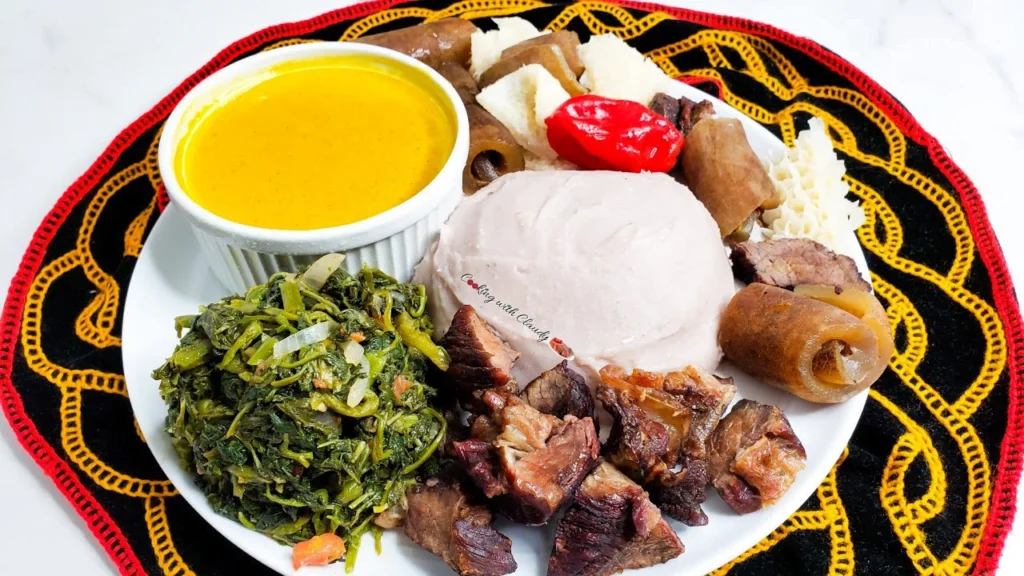

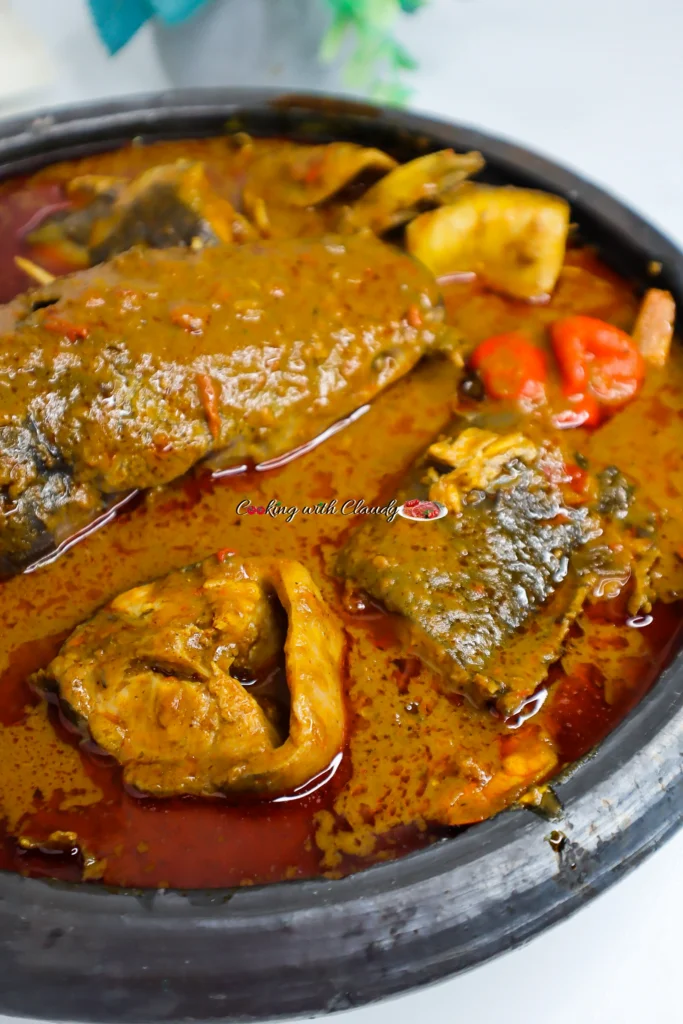
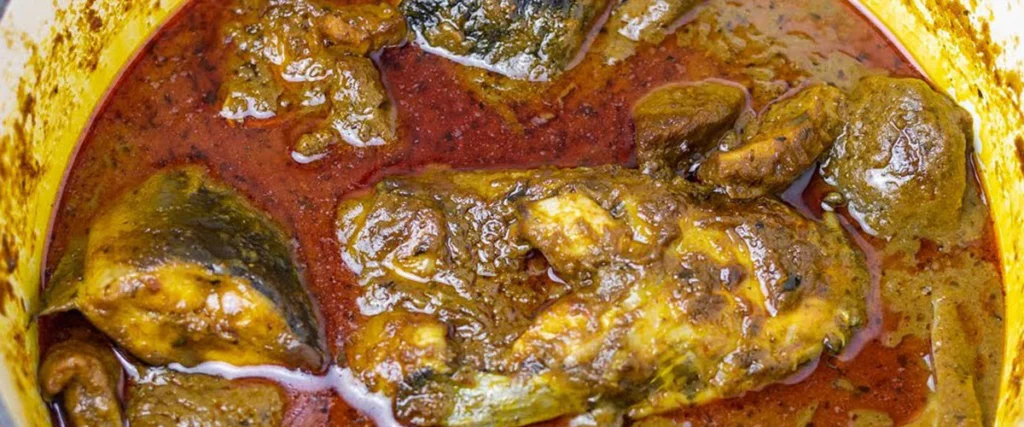



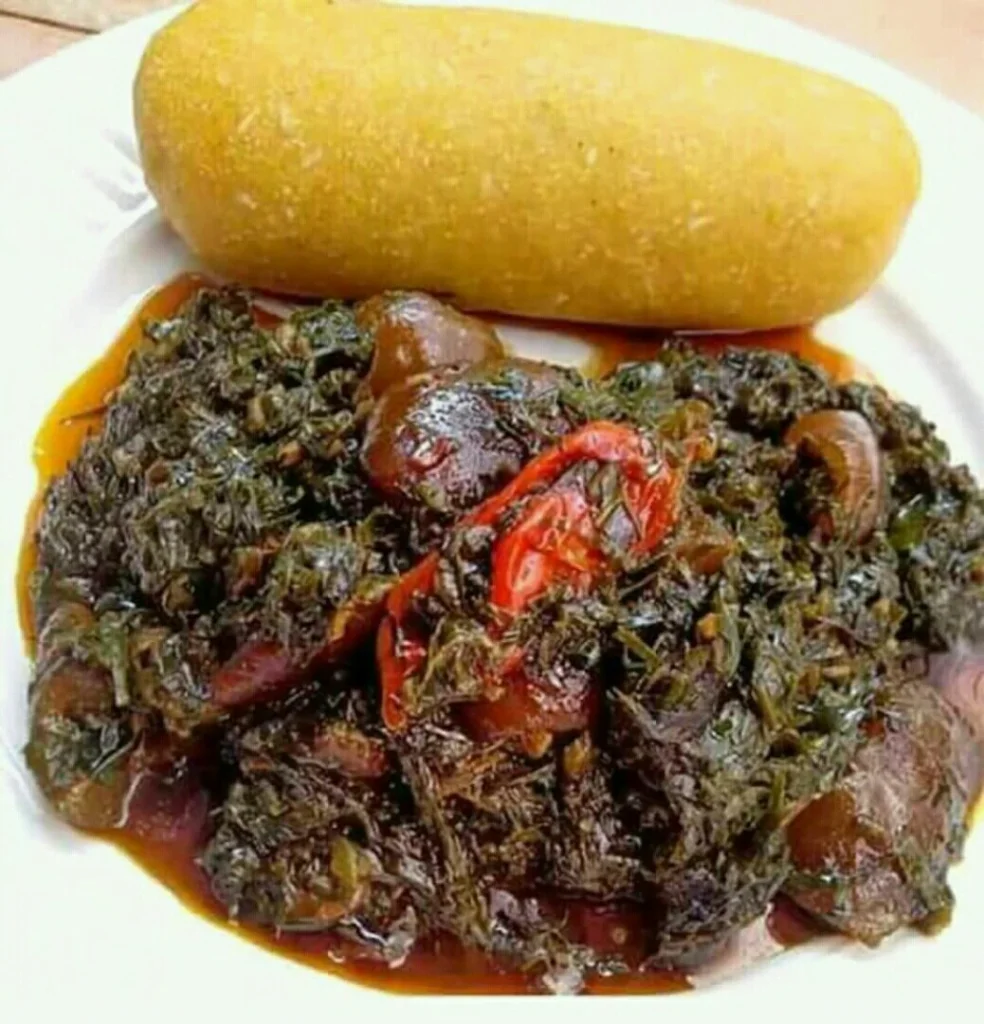
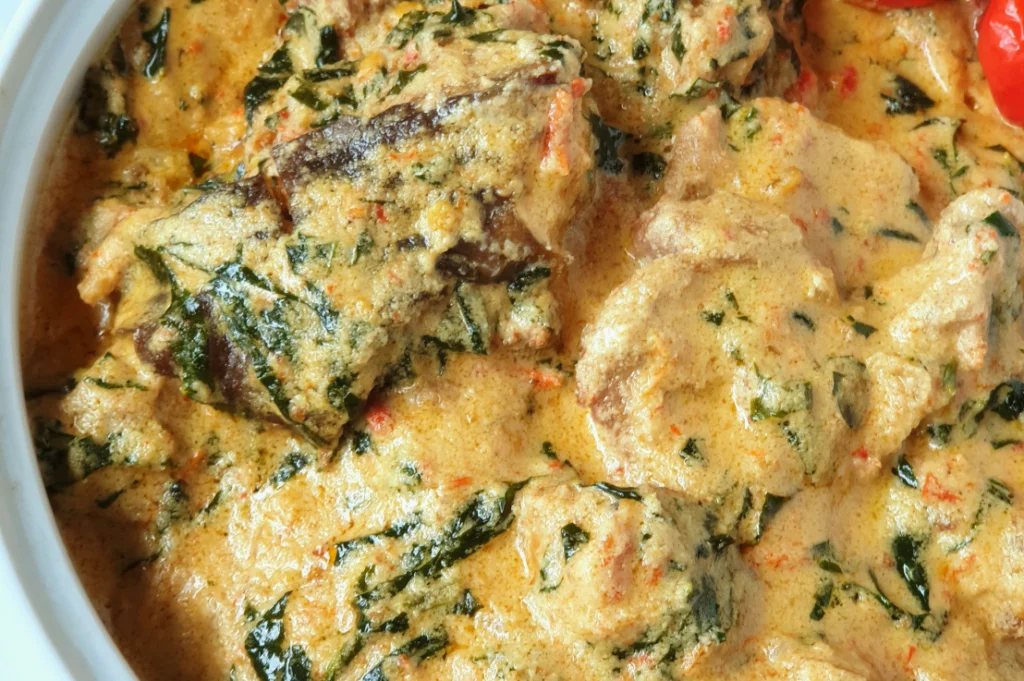
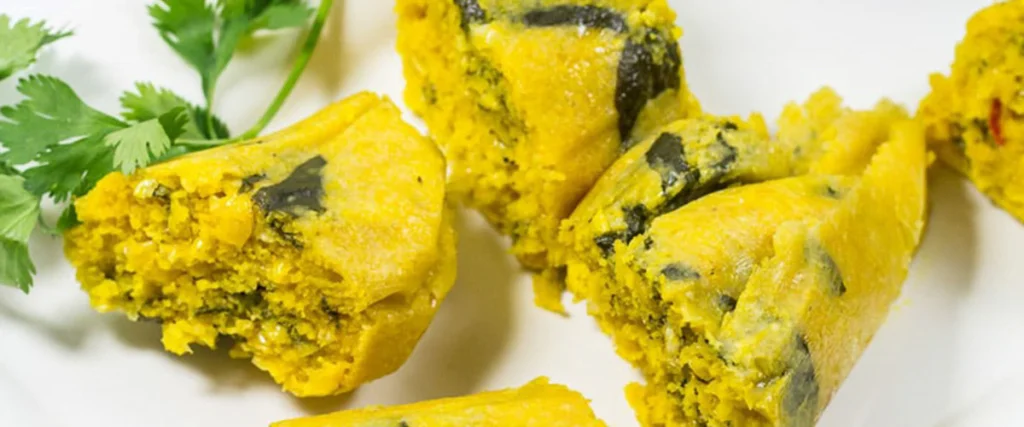

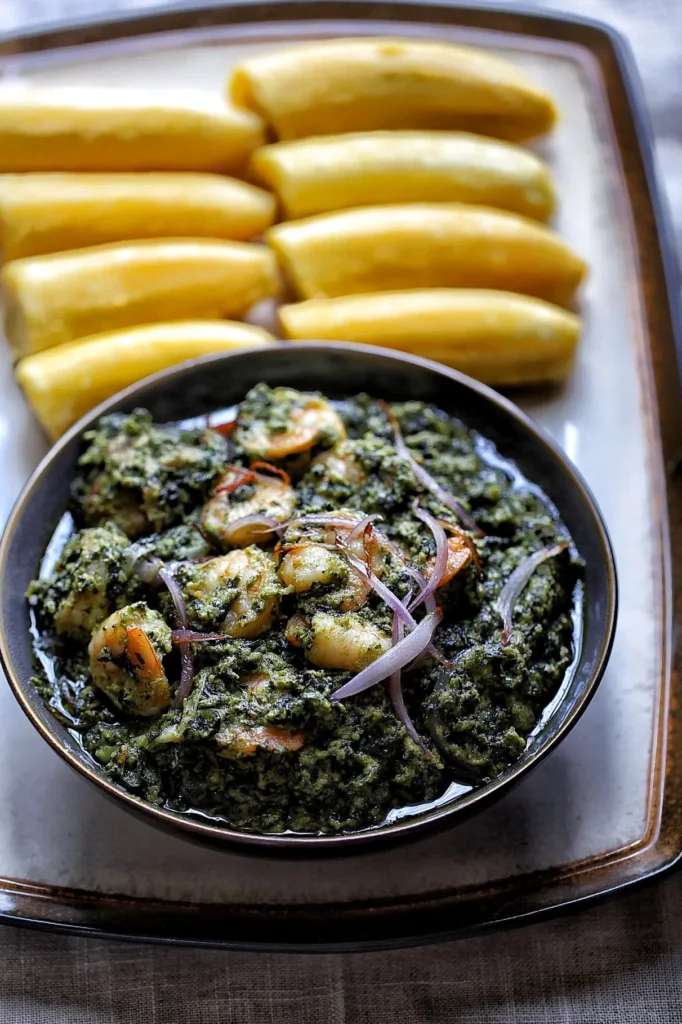



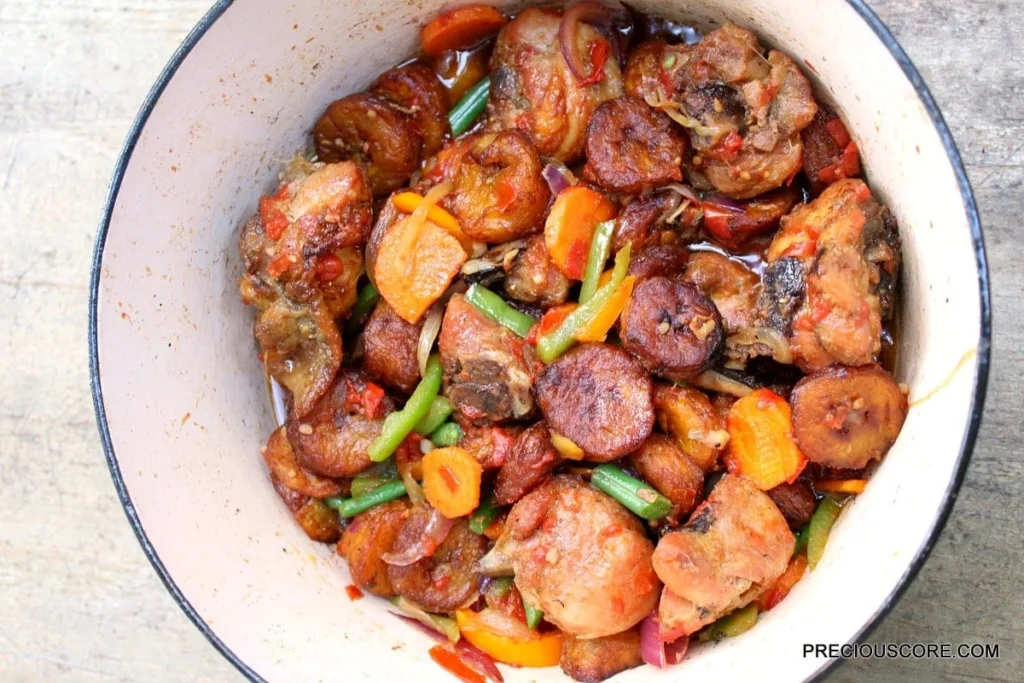
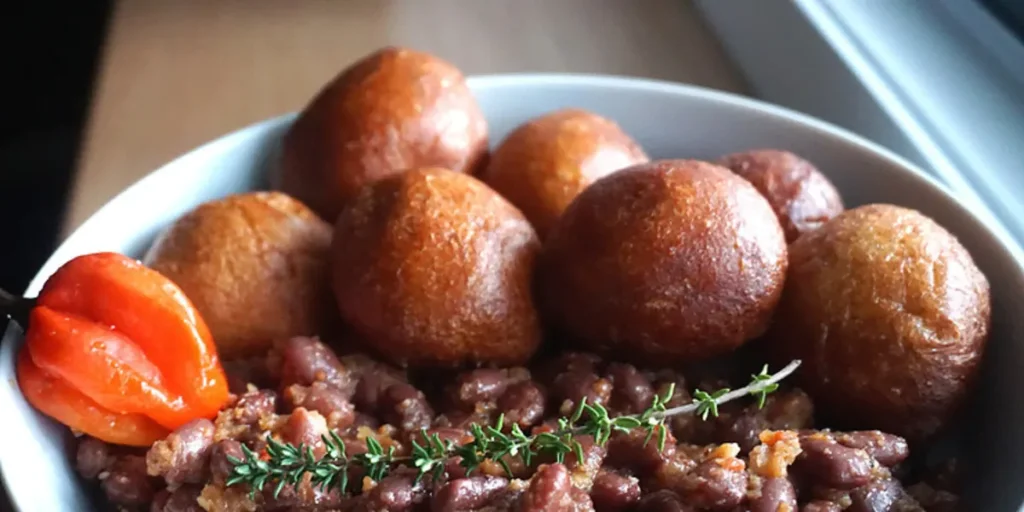


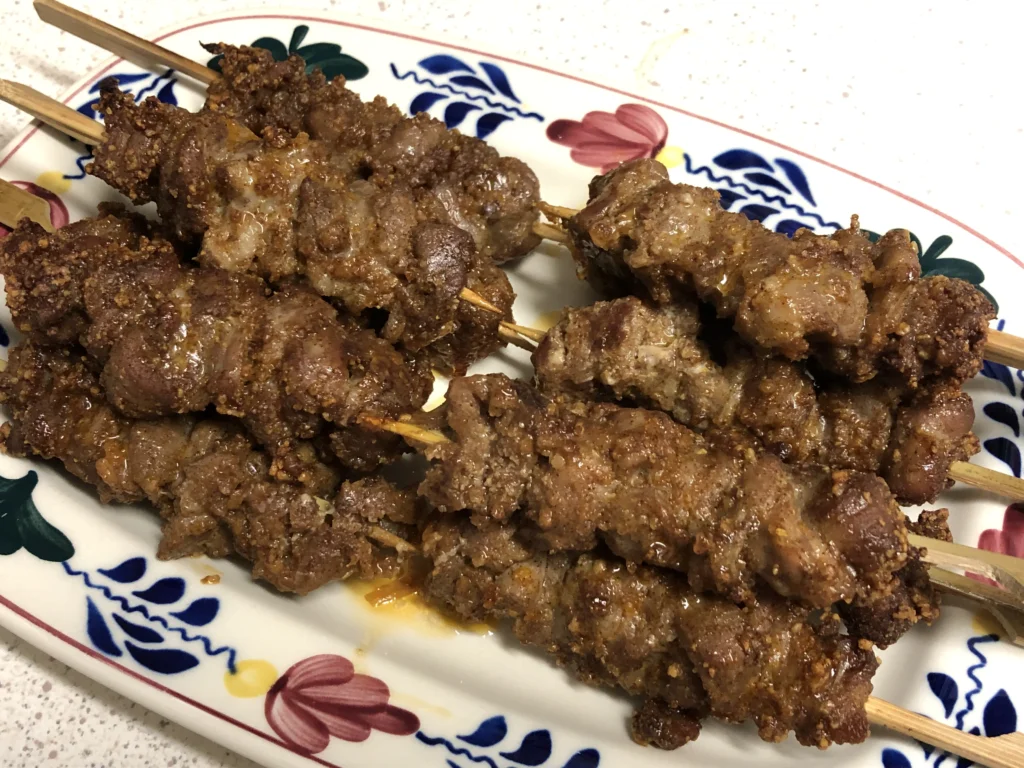
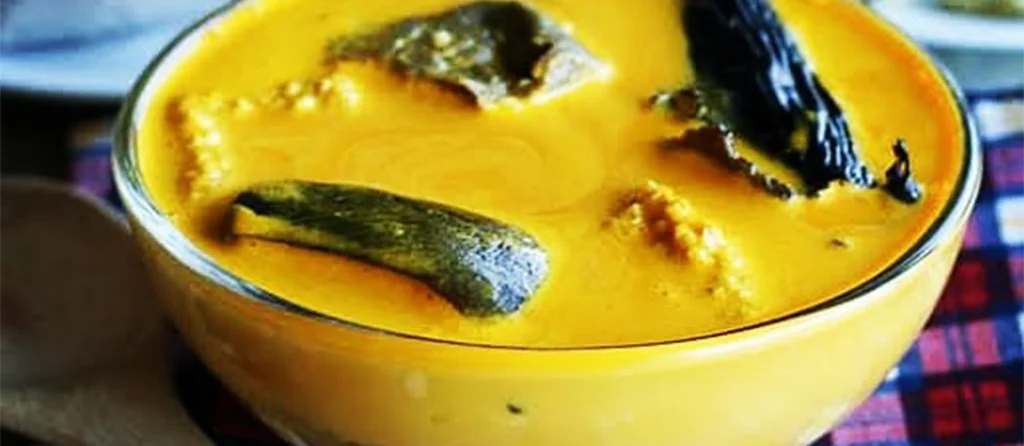

10 Interesting Facts about Cameroon

Welcome to a journey through Cameroon’s captivating history, where each twist and turn reveals fascinating insights into this diverse and culturally rich nation. From ancient traditions to modern-day legislation, here are 10 intriguing facts and laws that shed light on Cameroon’s historical tapestry.
Colonial Relics
Cameroon’s history is marked by colonization, with both Germany and France leaving enduring legacies. Today, remnants of this era can be seen in architectural marvels, cultural practices, and even legal frameworks.
Tale of Two Colonizers
Did you know that Cameroon was once split between German Kamerun and French Cameroun? This colonial division not only shaped the country’s borders but also left a lasting imprint on its linguistic and cultural landscape.
Independence Struggle

Cameroon gained independence from colonial rule in 1960 (for French Cameroon) and 1961 (for British Cameroon). The journey to independence was marked by political upheavals, grassroots movements, and the emergence of key figures like Ahmadou Ahidjo and John Ngu Foncha.
Unity in Diversity
Cameroon is often hailed as Africa in miniature due to its remarkable cultural diversity. With over 200 ethnic groups speaking more than 250 languages and dialects, the country’s cultural mosaic is a testament to its rich heritage.
Legal Oddities

Ever heard of the law forbidding women from wearing pants in Cameroon? Yes, it’s true! Though not strictly enforced in urban areas, this archaic law is still on the books, sparking debates about gender equality and societal norms.
Polygamy with a Twist
Polygamy for men is legal in Cameroon, but with a fascinating twist. The first wife holds significant legal power and must give consent before a man can take additional wives.
Volcanic Lakes

The country boasts stunning volcanic lakes, including Lake Nyos and Lake Monoun. Lake Nyos, in particular, is known for a tragic incident in 1986 when a sudden release of carbon dioxide killed thousands of people and animals.
Handshake Hierarchy
A firm handshake is a sign of respect in Cameroon, but there’s an unspoken hierarchy. The younger person or lower social status individual initiates the handshake, and elders or those of higher standing offer a handshake in return.
Mount Cameroon

Rising to an impressive 4,040 meters (13,255 feet), Mount Cameroon is an active volcano and the highest peak in West Africa. It offers challenging hiking opportunities and breathtaking views.
Soccer Passion
Cameroonians are passionate about soccer (football). The national team, known as the “Indomitable Lions,” has achieved success in international tournaments, including winning the African Cup of Nations multiple times.
Pygmies and Forests

The dense rainforests of southern Cameroon are home to Pygmy communities. These indigenous people have a deep connection to the forest and rely on it for sustenance.
Embark on a journey through Cameroon’s captivating history, where each fact and law reveal a layer of the country’s rich tapestry. From colonial relics to cultural celebrations, the story of Cameroon is as diverse and vibrant as the nation itself.
Cameroon’s History and the Effect It Has Had on the Cuisine

Cameroon’s story isn’t just etched in monuments and museums; it’s simmering in stews and whispered in the rustle of plantains. Let’s embark on a delicious adventure, exploring how each historical period has shaped the vibrant tapestry of Cameroonian cuisine.
Ancient Echoes (Pre-5th Century CE)
Humans have called Cameroon home for over 50,000 years! Archaeological whispers suggest the existence of powerful kingdoms. Imagine the first hearths crackling with life, their flames illuminating meals centered around wild game, native fruits, and starchy tubers – the foundation of early Cameroonian cuisine.
The Rise of the Sao (5th-15th Century CE)
Fast forward to Lake Chad, where the Sao Kingdom flourished from the 9th to the 15th century. Their legacy lives on not just in history books, but potentially on your plate! Crops like millet, sorghum, and indigenous vegetables likely formed the backbone of Sao cuisine.
The Kotoko Legacy (15th-19th Century CE)
The Sao story took a turn with the arrival of the Kotoko State. Conquering the Sao kingdom, their influence extended across northern Cameroon and Nigeria. Grains and legumes became prominent, reflecting the Kotoko culinary traditions that continue to shape local diets.
The Fulani Influence (18th Century CE)
The 18th century saw the arrival of the Fulani pastoralists in northern Cameroon. Islam, spreading through conquest and commerce, introduced new flavors. Lamb, fragrant spices, and the comforting warmth of millet couscous became part of the culinary landscape.
A Colonial Twist (Late 19th-20th Century)
European influence arrived with German and French colonial rule in the late 19th and 20th centuries. Freshly baked baguettes, the aroma of coffee, and the clinking of wine glasses became part of the culinary scene. This era witnessed a fascinating fusion of European and local flavors, laying the groundwork for Cameroon’s unique cuisine.
Independence and Beyond (1960-Present)

1960 marked a turning point as Cameroon gained independence. National identity took center stage, and so did iconic Cameroonian dishes. Ndolé, a vibrant green stew, Achu, a rich and flavorful stew with eru (melon seeds), and Poulet DG, a delicious chicken dish named after a former president, all became national favorites.
Modern Flavors (20th-21st Century)

Fast forward to today, where urbanization and globalization have added new chapters to the story. French and English influences mingle with indigenous traditions, creating a vibrant culinary scene. Restaurants, bustling street food stalls, and innovative fusion cuisine offer a kaleidoscope of flavors for every palate.
So, the next time you savor a Cameroonian dish, remember – it’s not just a meal, it’s a journey through time! Each bite whispers stories of ancient kingdoms, colonial encounters, and a nation’s vibrant spirit.
References
- Britannica: History of Cameroon
- Wikipedia: History of Cameroon
- ThoughtCo: A Brief History of Cameroon
How the Cameroon Climate and Geography has Influenced the Cuisine

Imagine a land where lush rainforests meet sun-drenched savannas, volcanic mountains pierce the sky, and the mighty Atlantic Ocean whispers secrets to the shore. This is Cameroon, a country blessed with breathtaking diversity that extends far beyond its landscapes. It spills over into every delicious bite of its cuisine!
A Crossroads of Flavors
Cameroon isn’t just a place; it’s a meeting point. Nicknamed the “African Crossroads,” it sits at the heart of West, Central, and North Africa. This strategic location has led to a vibrant exchange of culinary influences. Bantu, Semi-Bantu, and Shuwa Arab ethnicities each add their unique spice to the pot, creating a tapestry of flavors unlike any other.
Echoes of German, French, and English colonial legacies can also be found in baguettes, fragrant coffee, and delightful pastries.
A Symphony of Regions
Travel across Cameroon, and your taste buds will take a thrilling journey. The southern coastal plains, with their high humidity and abundant rainfall, are a paradise for tropical fruits, cassava, plantains, and, of course, fresh seafood.
Moving inland, the central Adamaoua Plateau offers a drier climate and a distinct cuisine featuring hearty stews and skewered meats. In the vast northern plains, where scorching temperatures meet minimal humidity, traditional stews simmer on open fires, often accompanied by succulent grilled meats.
Fertile volcanic soils in the western and northwestern regions, including the shadow of mighty Mount Cameroon, nourish a bounty of vegetables and fruits, adding vibrant color and freshness to local dishes.
A Seasonal Dance

Nature’s rhythms play a vital role in Cameroonian cuisine. Two distinct rainy seasons and a scorching dry season dictate what’s available and how it’s prepared. During the rainy months, vibrant green stews like “Ndolé” – a peanut butter and bitter leaf stew with seafood and beef – take center stage.
The dry season, however, welcomes dishes like “Puff Puff and Beans,” where fluffy doughnuts pair perfectly with the comforting warmth of corn porridge.
A Flavorful Adventure Awaits:
From the iconic “Fufu and Eru” (stewed eru with spinach, palm oil, and protein, served with fufu) to the diverse regional variations of “Okok” (a dish featuring Gnetum africanum leaves), Cameroon’s cuisine is an invitation to explore. So, grab your metaphorical fork and embark on a delicious journey through this land of breathtaking beauty and unforgettable flavors!
References
- Chef’s Pencil: 20 Most Popular Foods in Cameroon
- African Food Network: 18 Popular Cameroonian Foods You Should Try
- Travel Food Atlas: Cameroonian Food: 11 Must-Try Traditional Dishes of Cameroon
Understanding the Essence of Cameroon’s Cuisine
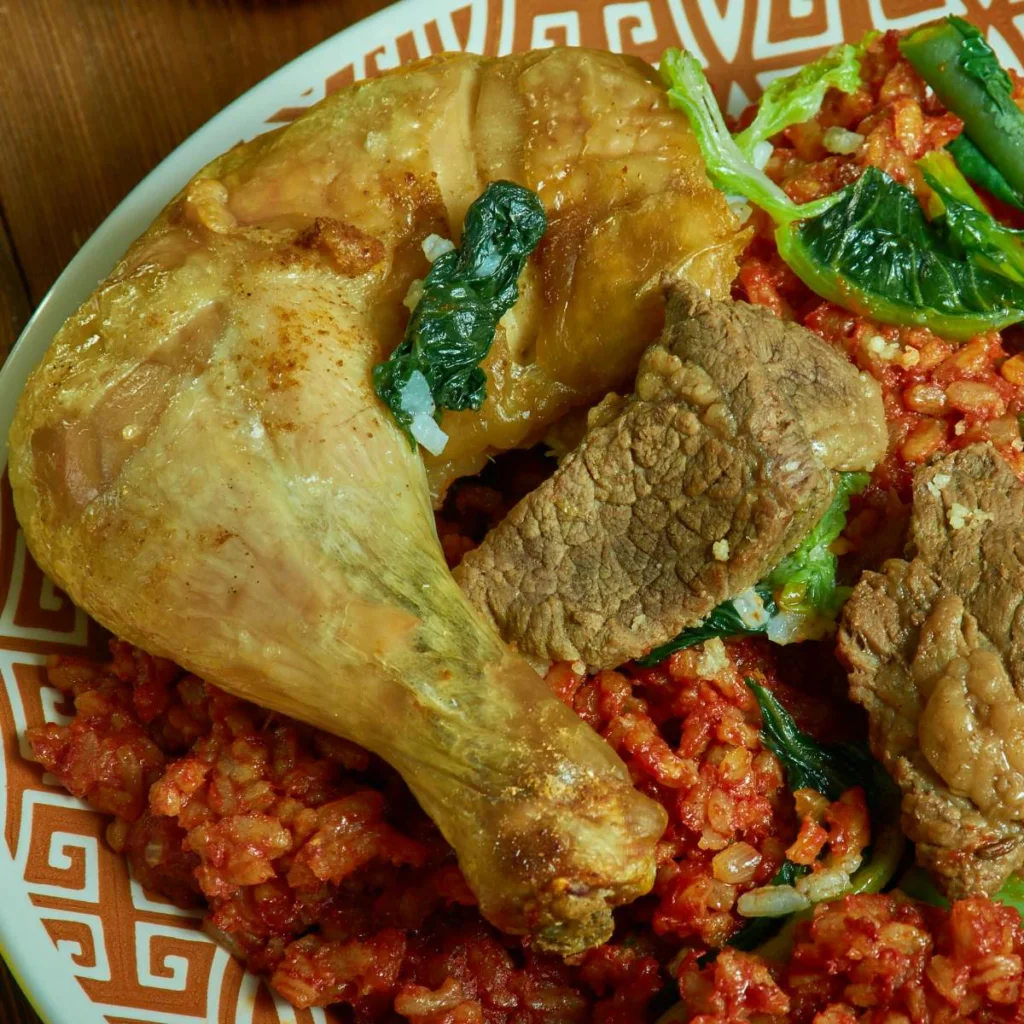
What makes a Cameroonian meal an unforgettable culinary adventure? Here, we delve into the essence of Cameroon’s cuisine, exploring the unique factors that create its distinct character.
A Crossroads of Influences
Imagine a bustling marketplace where flavors from across Africa and beyond converge. This is the essence of Cameroonian cuisine. Its location at the crossroads of West, Central, and North Africa has resulted in a fascinating fusion.
Hints of French baguettes mingle with the fiery spirit of North African spices. Hearty stews reminiscent of West Africa simmer alongside dishes showcasing the delicate touch of Central African cooking traditions. This fusion creates a symphony of flavors that is both familiar and refreshingly unexpected.
Local Ingredients, Global Inspiration
Cameroon boasts a diverse landscape, from lush rainforests to arid savannas. This translates into a bounty of unique local ingredients that form the foundation of its cuisine.
Ndolè, a signature Cameroonian dish, features bitter leaves (nkukuu) native to the region, while plantains, a staple across Africa, take center stage in many dishes.
However, Cameroon’s culinary story isn’t just about local bounty. Colonial influences have left their mark, with baguettes and flavorful spices adding a touch of international flair. The result? A cuisine that celebrates the richness of its local ingredients while embracing flavors from around the world.
The Art of Spice
Cameroonian cuisine isn’t shy when it comes to spice. From the fiery kick of ndombo (a local spice mix) to the subtle heat of chilies, spices are used to add depth, complexity, and a touch of excitement to dishes.
This isn’t just about heat; it’s about creating a harmonious balance of flavors that tantalizes the taste buds and leaves a lasting impression.
A Celebration of Technique
Cameroonian cooking techniques are as diverse as the landscape itself. From slow-simmering stews in the central regions to the art of grilling meats in the north, each region boasts its own culinary skills.
Fufu, a staple starch made from plantains or cassava, is meticulously pounded to achieve the perfect texture, while palm oil adds a unique richness to many dishes. Witnessing and experiencing these techniques is a window into the heart of Cameroonian cuisine.
Beyond Just Food: A Cultural Experience
A Cameroonian meal is more than just sustenance; it’s a cultural experience. Food is shared with loved ones and strangers alike, fostering a sense of community and togetherness. Meals are often accompanied by lively conversation and laughter, creating lasting memories that go beyond the flavors on the plate.
So, the next time you encounter Cameroonian cuisine, remember – it’s not just a meal; it’s a journey through a vibrant culture, a celebration of local ingredients, and a testament to the enduring spirit of a nation. Take a bite, savor the unique flavors, and unlock the captivating story behind this extraordinary cuisine.
Exploring Cameroon’s Ingredients: The Flavors of Cameroon’s Cuisine
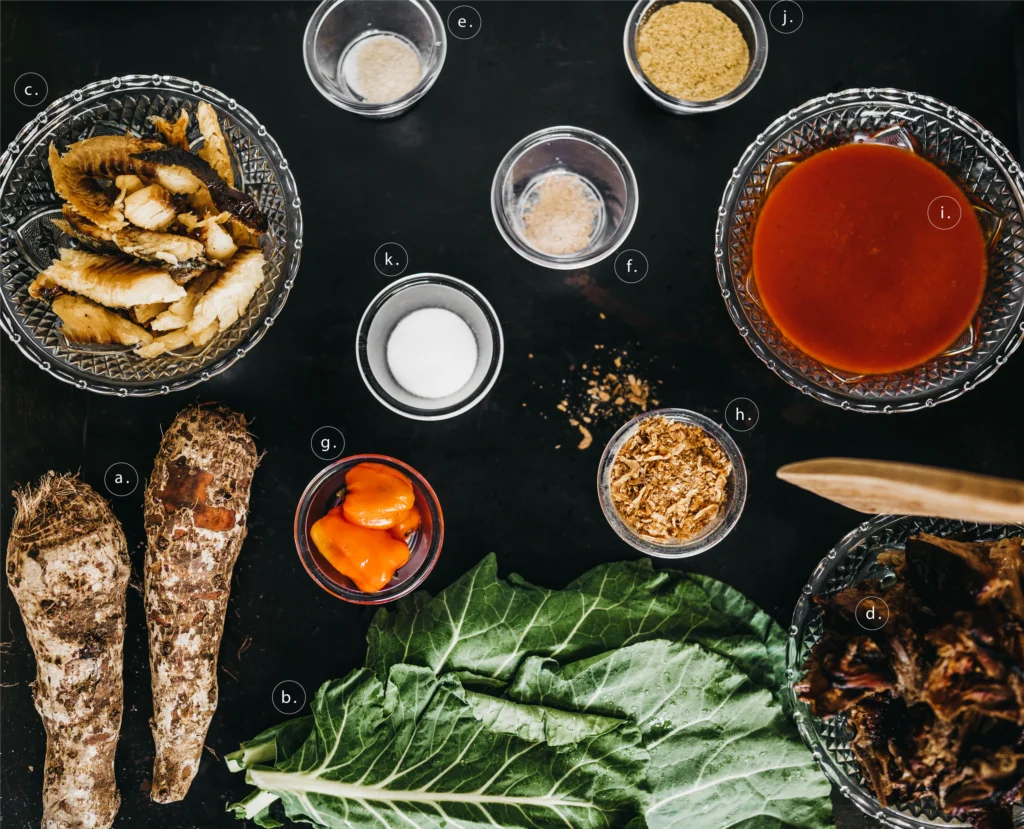
Cameroon’s cuisine is a vibrant explosion of flavor, a testament to the country’s rich diversity. But what are the building blocks, the essential ingredients that bring these dishes to life? Buckle up for a delicious exploration of the heart and soul of Cameroonian cooking!
Staples with Substance
- Starch Sensation: No Cameroonian meal is complete without a hearty dose of starch. Plantains, boiled, fried, or mashed, are a versatile staple. Fufu, a dough made from pounded plantains, cassava, or yams, provides a satisfying base for stews and soups.
- Mighty Maize: Corn, or maize as it’s locally known, takes center stage in many dishes. Enjoyed on its own, boiled and seasoned, or ground into flour for baking, maize adds a touch of sweetness and a powerful punch of energy to the diet.
A Symphony of Vegetables
Cameroon’s fertile lands yield a bounty of fresh vegetables that add vibrancy and essential nutrients to the cuisine.
- Ndole’s Hero: Nkukuu leaves, also known as bitter leaves, are a key ingredient in the iconic Ndolé dish. Their slightly bitter taste adds a unique depth of flavor.
- Green Giants: Leafy greens like spinach and eru (melon leaves) are simmered into stews and soups, providing essential vitamins and a pop of color.
- Okra’s Appeal: Okra, with its characteristic sliminess, adds texture and heartiness to stews and soups.
Proteins that Pack a Punch
Protein plays a vital role in Cameroonian cuisine, with a variety of options depending on region and preference.
- Seafood Symphony: The Atlantic coastline provides an abundance of fresh fish and seafood. From prawns and shrimp to barracuda and tilapia, these protein powerhouses are grilled, fried, or incorporated into stews and soups.
- Meat Matters: Beef, chicken, goat, and even bushmeat (in some regions) are popular choices for stews, grilled dishes, and skewered meats.
- Beans for Balance: Beans, both black and white varieties, offer a budget-friendly protein source and add a touch of creaminess to stews and soups.
The Art of Spice
Cameroon’s cuisine wouldn’t be the same without its vibrant spice palette.
- Ndombo’s Magic: This local spice mix, a blend of ingredients like dried shrimp, chili peppers, and nuts, adds a smoky depth and a touch of heat to many dishes.
- Chili’s Kick: Chilies, from mild to fiery, are used to add a range of heat levels, depending on the region and individual preference.
- Peanuts for Power: Peanuts, ground or whole, add richness and a nutty depth of flavor to stews and sauces.
Oils and Aromatics
Fats play a crucial role in adding flavor and texture to Cameroonian dishes.
- Palm Power: Palm oil, a deep red oil extracted from the palm fruit, adds a unique richness and characteristic flavor to many dishes.
- Aromatic Alliums: Onions, garlic, and ginger are essential flavoring agents, building the base for delicious stews and soups.
Beyond the Ingredients: A Culinary Journey Awaits
These core ingredients are just the beginning of the culinary adventure that awaits in Cameroon. Each region boasts its own specialties and variations, influenced by local traditions and available ingredients.
So, the next time you encounter Cameroonian cuisine, remember – it’s a vibrant tapestry woven from these essential ingredients, a testament to the creativity and resourcefulness of the Cameroonian people. Take a bite, explore the unique flavors, and embark on a delicious journey through this extraordinary culinary landscape!
Cameroon’s National Food
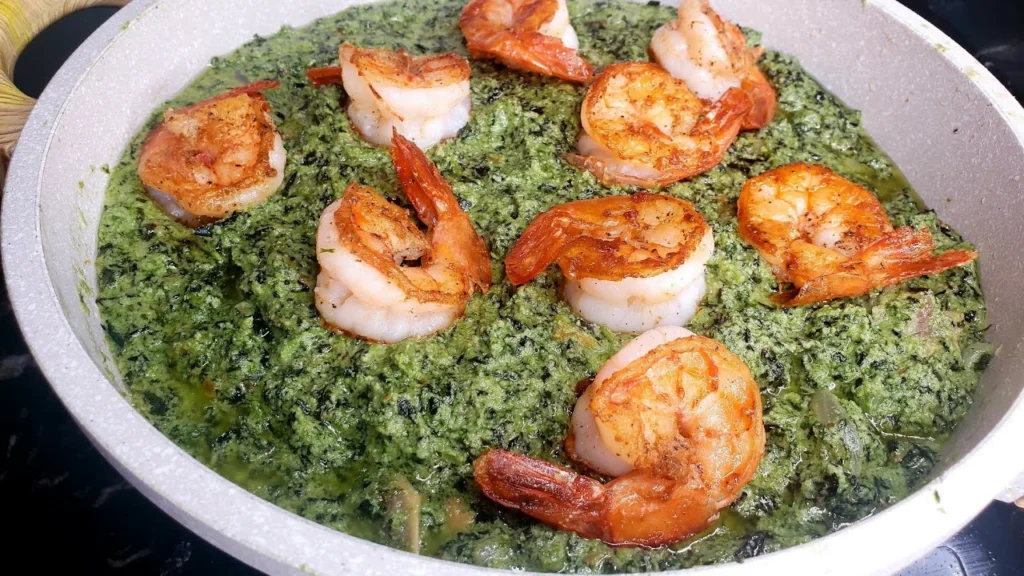
If you see a vibrant green stew bubbling away, chances are you’re witnessing the creation of a national treasure – Ndolé. More than just a dish, Ndolé is a culinary ambassador, a symbol of Cameroonian identity, and a flavor explosion waiting to be savored.
A Symphony of Flavors
Ndolé’s heart lies in its unique combination of ingredients. The star of the show is undoubtedly nkuukuu, also known as bitter leaves. Indigenous to West and Central Africa, these leaves add a distinct bitterness that forms the base of the dish’s complex flavor profile.
But Ndolé doesn’t stop there. Peanuts, ground to a smooth paste, lend a creamy richness, while crayfish and meat (often beef or chicken) provide a hearty protein punch. A vibrant blend of spices, including nsombo (a local spice mix), chilies, and sometimes shrimp paste, brings depth and a touch of heat. The result? A symphony of flavors that is both comforting and exciting, a true reflection of Cameroon’s diverse culinary heritage.
Beyond the Plate: A Cultural Experience
Ndolé isn’t just a dish; it’s a cultural experience. It’s a staple at celebrations, a symbol of hospitality, and a dish shared with loved ones and guests alike. The communal act of gathering around a bowl of Ndolé, served with a side of fufu (a starchy dough) or plantains, fosters a sense of connection and togetherness.
Exploring Cameroon’s Street Food
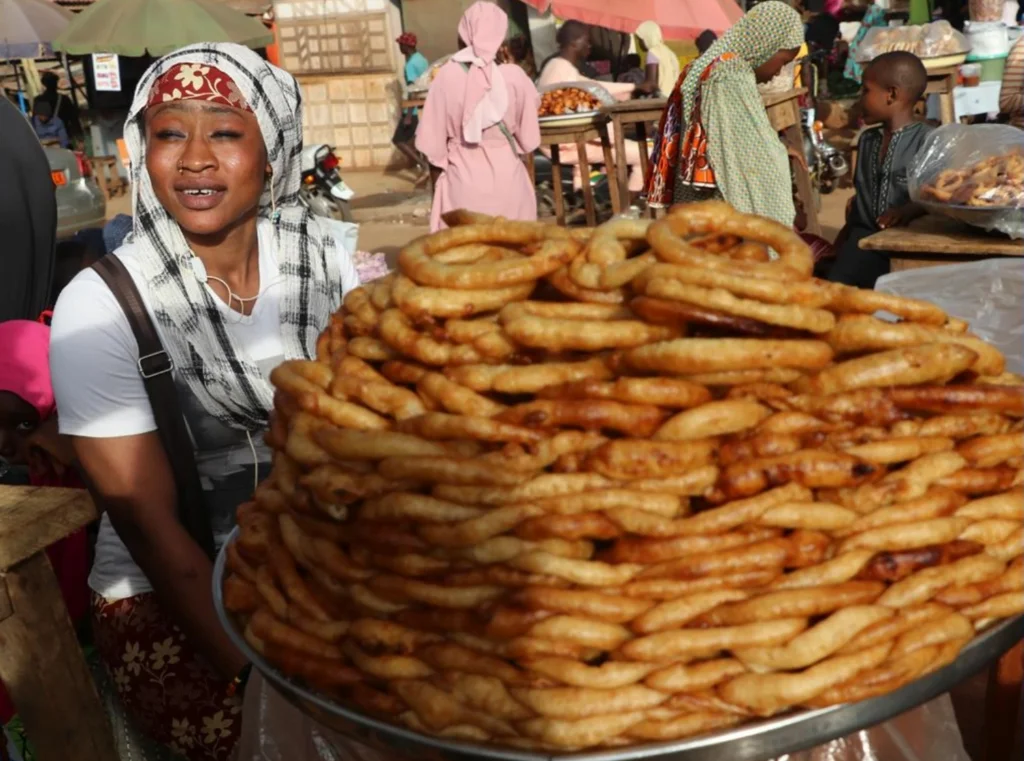
Step onto the bustling streets of Cameroon and you’ll be greeted by a symphony of tantalizing aromas and sizzling delights. From savory snacks to sweet treats, the country’s street food scene offers a culinary adventure like no other. Join us as we delve into the heart of Cameroon’s street food culture, uncovering five common recipes that you simply can’t miss, and discovering which cities boast the most vibrant street food scenes.
Nkono – The King of Street Food
Also known as grilled plantains, Nkono is a ubiquitous street food favorite across Cameroon. Slices of ripe plantains are grilled to perfection over an open flame, imparting a delightful smoky flavor. Often served with spicy pepper sauce or roasted peanuts, nkono is a satisfying snack enjoyed by locals and visitors alike.
City Hotspot: Head to the streets of Douala, Cameroon’s largest city and economic hub, to experience nkono at its finest. With vendors lining busy thoroughfares and bustling markets, Douala offers a vibrant setting to savor this beloved street food delicacy.
Suya – Spice Up Your Taste Buds
Suya originates from the northern regions of Cameroon, suya is a flavorful skewered meat dish that’s a staple of street food culture. Marinated in a blend of aromatic spices and grilled to perfection, suya packs a punch of flavor with every bite. Whether it’s beef, chicken, or goat, suya is a savory delight that’s sure to satisfy.
City Hotspot: Venture to the streets of Yaoundé, Cameroon’s capital city, to indulge in the savory delights of suya. From bustling markets to lively street corners, Yaoundé offers a diverse array of suya vendors eager to tantalize your taste buds with their mouthwatering creations.
Akara – Crispy Fritters of Delight
Akara, or bean fritters, is a beloved street food snack found throughout Cameroon. Made from ground black-eyed peas blended with onions, spices, and herbs, akara is deep-fried until golden brown, resulting in a crispy exterior and soft, fluffy interior. Served hot and fresh, akara is a popular breakfast or snack option for Cameroonians on the go.
City Hotspot: Explore the streets of Bamenda, nestled in the scenic highlands of northwest Cameroon, to discover the irresistible allure of akara. Whether it’s from roadside stalls or bustling markets, Bamenda’s vibrant street food scene offers a plethora of options to satisfy your craving for these crispy fritters.
Koki Corn – A Taste of Tradition
Koki corn, also known as corn pudding, is a traditional Cameroonian dish that’s commonly sold as street food. Made from ground corn kernels mixed with spices, palm oil, and sometimes beans, koki corn is steamed to perfection, resulting in a hearty and flavorful dish. With its rich and creamy texture, koki corn is a comforting treat that’s perfect for any time of day.
City Hotspot: Immerse yourself in the vibrant street food scene of Bafoussam, located in the heart of Cameroon’s West Region, to sample the authentic flavors of koki corn. From bustling markets to roadside vendors, Bafoussam offers a taste of tradition that’s sure to leave a lasting impression.
Beignets – Sweet Indulgence on the Go
Beignets, or deep-fried doughnuts, are a popular street food snack enjoyed throughout Cameroon. Whether dusted with powdered sugar or drizzled with syrup, beignets are a sweet indulgence that’s perfect for satisfying your cravings on the go. With their crispy exterior and soft, pillowy interior, beignets are a beloved treat for Cameroonians of all ages.
City Hotspot: Make your way to the vibrant streets of Buea, nestled at the foot of Mount Cameroon, to indulge in the sweet delights of beignets. Whether you’re strolling through bustling markets or exploring lively street corners, Buea offers a delightful array of beignet vendors eager to tempt your taste buds with their irresistible creations.
The Most Popular Cameroon Recipes

Embark on a delicious journey as we explore 10 of the most popular Cameroonian recipes, each offering a taste of this extraordinary culinary landscape:
Ndolé (National Treasure)
Dive into Cameroon’s national dish – a vibrant green stew featuring bitter leaves (nkuukuu), creamy peanut butter, seafood, and a symphony of spices. Served with fufu (starchy dough) or plantains, it’s a flavor explosion and a cultural experience in a bowl.
Achu (Spicy Delight)
Achu is a rich and fiery stew simmered with eru (melon seeds), palm oil, and a generous amount of nsombo (a local spice mix). Often featuring chicken, goat, or fish, Achu is a hearty and flavorful dish that will tantalize your taste buds.
Poulet DG (A Presidential Favorite)
Named after a former president, Poulet DG is a decadent dish featuring chicken braised in a flavorful tomato and peanut butter sauce. Often accompanied by fried plantains or rice, it’s a luxurious culinary tribute to Cameroonian ingenuity.
Fufu and Eru (A Classic Combo)
This iconic duo is a staple in Cameroon’s northwest and southwest regions. Eru, a leafy green simmered with spinach, palm oil, and smoked fish or beef, provides a rich base for the fufu – a starchy dough made from plantains or cassava. It’s a simple yet satisfying dish bursting with flavor.
Okok (Regional Variations)
Okok is a fascinating dish with variations across different ethnic groups. All versions share a common base – Gnetum africanum leaves, with each group adding their own unique touch. Explore the diverse flavors of Bassa, Eton, and Yabassi Okok, and discover the culinary soul of Cameroon’s regions.
Banga Soup (Peanut Powerhouse)
Banga soup is a rich and flavorful stew originating from the Littoral and Southwest regions. Peanuts are the star of the show, ground into a smooth paste and simmered with palm oil, meat (often beef or chicken), and a variety of spices. It’s a comforting and deeply satisfying dish.
Dodo (Sweet Plantain Perfection)
Dodo are fried plantains, a beloved street food and a versatile side dish. Ripe plantains are sliced and deep-fried to crispy perfection, offering a delightful balance of sweetness and texture to any meal.
Mfam (Spicy Grilled Goodness)
Mfam is a grilled meat dish popular in the western and northwestern regions. Marinated in a blend of spices, including chili peppers and nsombo, the meat (often chicken, goat, or fish) is grilled over an open fire, resulting in a smoky, flavorful, and slightly spicy treat.
Mbongo Tchobi (Spicy Collard Green Delight)
This flavorful dish features collard greens simmered with smoked fish, shrimp, and a generous amount of chili peppers. Mbongo Tchobi is a fiery and satisfying stew, perfect for those who love a good kick.
Puff Puff and Beans (Sweet and Savory Street Food)
No exploration of Cameroonian cuisine is complete without indulging in street food. Puff Puff are fluffy, deep-fried doughnuts, often enjoyed alongside a bowl of “beans” – a savory porridge made with corn or black-eyed peas. It’s a sweet and savory combination that is as delicious as it is unexpected.
How Healthy is Cameroon’s Food?

Cameroon’s story isn’t just about breathtaking landscapes and vibrant cultures; it’s also a story about health. The country faces a complex challenge, balancing the health benefits of its traditional cuisine with the rising burden of non-communicable diseases (NCDs). Let’s delve into the delicious world of Cameroonian food and explore its impact on national health.
A Treasure Trove of Tradition:
Cameroon’s cuisine boasts several health-promoting aspects:
- Fresh Feast: Local fruits, vegetables, and whole grains form the foundation of many dishes, offering essential vitamins, minerals, and fiber.
- Lean Protein Powerhouse: Fish, poultry, and legumes are prominent players, providing a healthy dose of protein without excessive saturated fat.
- Spice Up Your Life: Flavorful seasonings like garlic, ginger, and turmeric add a delicious twist while potentially offering additional health benefits.
Challenges on the Horizon:
However, some aspects of the Cameroonian diet pose potential health risks:
- Palm Oil Paradox: While it adds a depth of flavor, palm oil is high in saturated fat. Consumed in moderation, it can be part of a balanced diet, but excessive intake can be detrimental.
- Processed Food Peril: Urbanization has led to a rise in processed food consumption. These foods may be lower in essential nutrients and higher in unhealthy fats, sugars, and sodium.
- Salt Shakers on High Alert: Traditional dishes can sometimes be on the saltier side due to seasoning and preservation methods. While salt adds flavor, excessive intake can contribute to high blood pressure.
The NCD Threat:
NCDs like cardiovascular disease, chronic respiratory diseases, cancer, and diabetes are a growing concern in Cameroon. In 2021 alone, the age-standardized mortality rate for NCDs was significantly higher in males compared to females. This highlights the urgency of addressing the rise of NCDs.
A Nation in Transition:
Cameroon is experiencing an “epidemiological transition,” where NCDs are becoming a bigger health concern alongside existing challenges like communicable diseases (such as HIV/AIDS).
Looking Forward:
Cameroon’s vibrant cuisine holds the potential to be a powerful tool for promoting health. By promoting traditional practices that focus on fresh ingredients, lean proteins, and flavorful spices, while also moderating palm oil intake and reducing reliance on processed foods, Cameroon can create a healthier future for its people.
References
Cameroon’s Cuisine Recipes to Try at Home
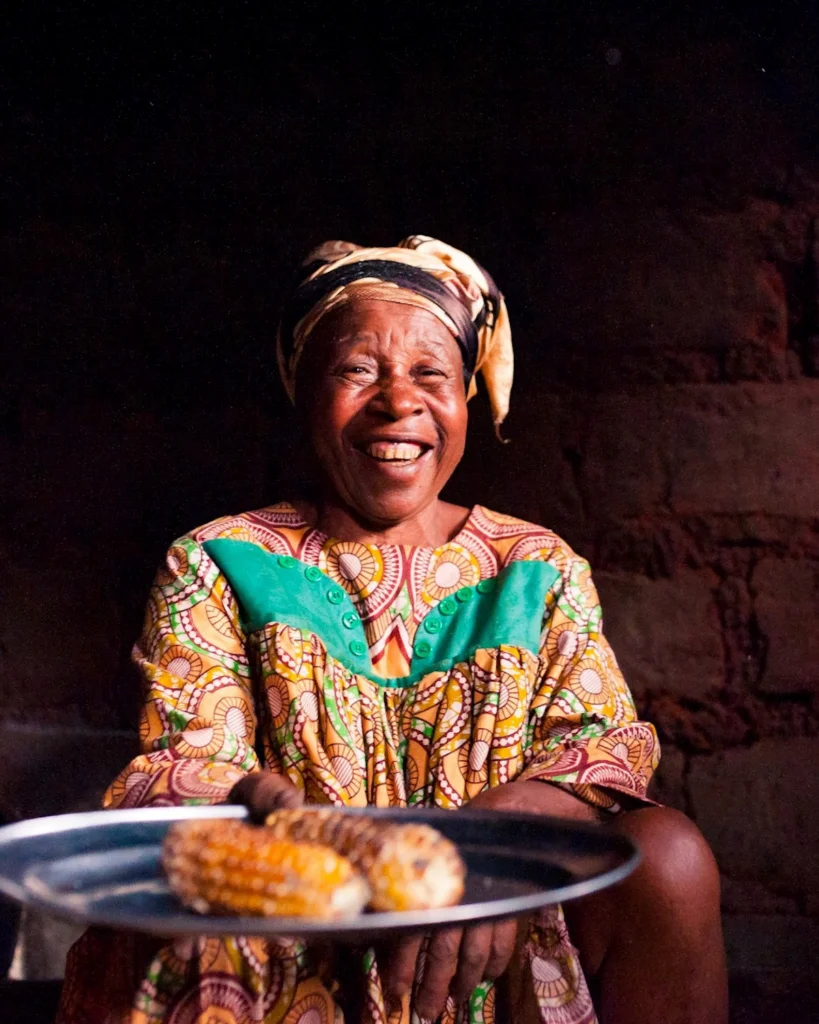
Craving an adventure beyond the ordinary? Look no further than the vibrant cuisine of Cameroon! Imagine simmering stews bursting with bold flavors, fluffy doughnuts dusted with sugar, and savory grilled meats kissed by smoke. This chapter is your gateway to experiencing these culinary delights in the comfort of your own kitchen.
We’ve curated a collection of detailed, easy-to-follow Cameroonian recipes, perfect for both novice and seasoned cooks. Whether you’re drawn to the national treasure – Ndolé, a vibrant green stew with bitter leaves and seafood – or fancy trying Achu, a fiery stew simmered with eru (melon seeds) and palm oil, you’ll find everything you need to embark on a delicious culinary journey.
Each recipe is accompanied by clear instructions, a list of readily available ingredients, and helpful tips to ensure success. So, ditch the takeout menus and get ready to tantalize your taste buds with the unique flavors of Cameroon. Let’s explore the heart of this extraordinary cuisine, one delicious bite at a time!
Cameroon Food – Puff Puff and Beans

Exploring the Flavors of Cameroon: Puff Puff and Beans
As a traveling food blogger with a passion for exploring culinary delights from around the world, I’m excited to share with you a taste of Cameroonian cuisine. Today, let’s dive into the heart of Cameroon’s street food scene with a classic dish: Puff Puff and Beans.
Originating from the vibrant streets of Cameroon, this flavorful combination is a beloved comfort food that embodies the rich culinary heritage of the region.
History and Background
Puff Puff and Beans is a popular street food dish in Cameroon, particularly enjoyed in urban areas like Douala and Yaoundé. Puff Puff, a type of fried dough similar to doughnuts, is paired with a hearty bean stew, creating a satisfying and comforting meal.
This dish reflects the fusion of African and European culinary influences in Cameroon, with elements of both traditional African ingredients and colonial-era cooking techniques.
Cameroon Food – Puff Puff and Beans Ingredients
For Puff Puff:
- 2 cups all-purpose flour
- 1/4 cup granulated sugar
- 1 teaspoon active dry yeast
- 1 cup warm water
- Vegetable oil for frying
For Beans Stew:
- 1 cup dried black-eyed peas
- 1 onion, chopped
- 2 tomatoes, diced
- 2 cloves garlic, minced
- 1 tablespoon tomato paste
- 1 teaspoon paprika
- 1 teaspoon ground cumin
- Salt and pepper to taste
- Water for cooking
Cameroon Food – Puff Puff and Beans Recipe
Puff Puff (Serves 4)
Ingredients:
- 2 cups all-purpose flour
- 1/4 cup granulated sugar
- 1 teaspoon active dry yeast
- 1 cup warm water
- Vegetable oil for frying
Steps:
- In a large mixing bowl, combine the flour, sugar, and yeast. Gradually add the warm water, stirring until a thick batter forms.
- Cover the bowl with a clean kitchen towel and let the batter rest in a warm place for about 1 hour, or until it doubles in size.
- In a deep saucepan or fryer, heat the vegetable oil over medium heat until it reaches 350°F (175°C).
- Using a spoon or your hands, carefully drop small portions of the batter into the hot oil, frying them until golden brown and crispy, about 3-4 minutes per side.
- Once cooked, remove the puff puff from the oil and drain them on paper towels to remove excess oil.
- Serve the puff puff warm with the beans stew for dipping or on the side.
Beans Stew (Serves 4)
Ingredients:
- 1 cup dried black-eyed peas
- 1 onion, chopped
- 2 tomatoes, diced
- 2 cloves garlic, minced
- 1 tablespoon tomato paste
- 1 teaspoon paprika
- 1 teaspoon ground cumin
- Salt and pepper to taste
- Water for cooking
Steps:
- Rinse the dried black-eyed peas under cold water, then soak them in water for at least 4 hours or overnight.
- In a large pot, heat some oil over medium heat. Add the chopped onion and minced garlic, sautéing until fragrant and translucent.
- Add the diced tomatoes, tomato paste, paprika, ground cumin, salt, and pepper to the pot, stirring to combine.
- Drain the soaked black-eyed peas and add them to the pot, along with enough water to cover them completely.
- Bring the mixture to a boil, then reduce the heat and let it simmer for about 45-60 minutes, or until the beans are tender and the stew has thickened.
- Adjust the seasoning to taste, adding more salt and pepper if needed.
- Serve the beans stew hot alongside the freshly fried puff puff for a delicious and satisfying meal.
Cooking Time: Approximately 1 hour 30 minutes
Nutritional Information: (Per serving of Puff Puff and Beans)
- Calories: 425 kcal
- Carbohydrates: 84g
- Protein: 13g
- Fat: 3g
- Fiber: 9g
Cameroon Food – Ndolé (A Peanut Butter and Bitter Leaf Stew with Seafood and Beef)

Exploring Cameroon Cuisine: Ndolé, a Rich Blend of Flavors
Cameroon, nestled in West Africa, boasts a culinary scene that reflects its diverse cultural tapestry. Ndolé, a signature dish, embodies the fusion of indigenous flavors with colonial influences. This hearty stew, featuring peanut butter and bitter leaf, is a beloved comfort food in Cameroonian households, offering a tantalizing taste of the region’s culinary heritage.
Cameroon Food – Ndolé Ingredients:
- 1 pound (450g) beef, cubed
- 1 pound (450g) seafood mix (shrimp, crab, or prawns)
- 2 cups (360g) bitter leaf, chopped (substitute spinach if unavailable)
- 1 cup (250g) peanut butter
- 1 large onion, finely chopped
- 3 cloves garlic, minced
- 1 red bell pepper, diced
- 2 ripe tomatoes, chopped
- 2 tablespoons (30ml) palm oil (or vegetable oil)
- 1 teaspoon (5g) ground crayfish (optional)
- 1 teaspoon (5g) ground dried shrimp (optional)
- Salt and pepper to taste
- Water, as needed
Cameroon Food – Ndolé Recipe:
Preparing Ingredients:
- Marinate Beef and Seafood:
- In separate bowls, season the beef and seafood with salt and pepper. Set aside for at least 30 minutes to marinate.
Cooking Process:
- Sauté Onions and Garlic:
- Heat palm oil in a large pot over medium heat. Add chopped onions and minced garlic. Sauté until fragrant and golden brown.
- Brown Beef:
- Add the marinated beef to the pot. Cook until browned on all sides, stirring occasionally.
- Add Tomatoes and Peppers:
- Incorporate the diced tomatoes and red bell peppers into the pot. Cook until the vegetables soften and release their juices.
- Integrate Peanut Butter:
- Stir in the peanut butter, gradually adding water to achieve desired consistency. Mix until the peanut butter is fully incorporated and forms a thick sauce.
- Simmer with Seafood:
- Gently add the marinated seafood to the pot. Allow the stew to simmer over low heat, ensuring the seafood is cooked through.
- Incorporate Bitter Leaf:
- Fold in the chopped bitter leaf (or spinach) into the stew. Simmer for an additional 5-7 minutes until the greens wilt and integrate with the flavors.
- Season to Taste:
- Adjust seasoning with salt, pepper, and optional ground crayfish and dried shrimp, enhancing the stew’s depth of flavor.
Serving:
- Serve Ndolé hot, accompanied by steamed rice or boiled yams for a wholesome and satisfying meal.
Serving Size and Nutritional Information:
- Serves: 4-6 people
- Calories: Approximately 350 per serving (may vary based on portion size and ingredients)
- Nutritional Information: Rich in protein, vitamins, and healthy fats from seafood, beef, peanut butter, and vegetables. Contains moderate carbohydrates from rice or yams, contributing to sustained energy levels.
Cameroon Food – Fufu and Eru (Stewed Eru with Spinach, Palm Oil, And Protein, Served with Fufu)

Unraveling the Flavors of Cameroon: Fufu and Eru
A traditional Cameroonian dish, exemplify the fusion of indigenous ingredients and culinary techniques. This hearty meal, featuring stewed eru with spinach, palm oil, and protein, served alongside fufu, offers a taste of the country’s cultural diversity and gastronomic traditions.
Cameroon Food – Fufu and Eru Ingredients:
- 2 cups (400g) cassava flour
- 2 cups (400g) water
- 2 cups (360g) eru leaves, chopped (substitute spinach if unavailable)
- 1 cup (240ml) palm oil
- 1 onion, finely chopped
- 2 cloves garlic, minced
- 1 pound (450g) protein (chicken, beef, or fish), cubed or sliced
- 2 ripe tomatoes, diced
- 1 tablespoon (15g) ground crayfish (optional)
- Salt and pepper to taste
- Water, as needed
Cameroon Food – Fufu and Eru Recipe:
Preparing Ingredients:
- Prepare Fufu Dough:
- In a large bowl, combine cassava flour with water. Knead until a smooth, elastic dough forms. Roll into small balls and set aside.
- Prepare Eru Leaves:
- Wash and chop the eru leaves (or spinach) finely. Set aside.
Cooking Process:
- Saute Aromatics:
- Heat palm oil in a large pot over medium heat. Add chopped onions and minced garlic. Saute until translucent and fragrant.
- Brown Protein:
- Add the cubed or sliced protein (chicken, beef, or fish) to the pot. Cook until browned on all sides, stirring occasionally.
- Incorporate Tomatoes:
- Stir in the diced tomatoes, allowing them to soften and release their juices.
- Add Eru Leaves:
- Integrate the chopped eru leaves (or spinach) into the pot. Stir well to combine with the protein and aromatics.
- Seasoning and Simmering:
- Season the stew with salt, pepper, and optional ground crayfish for added flavor. Add water as needed to achieve desired consistency. Allow the stew to simmer over low heat for 20-25 minutes, allowing the flavors to meld together.
- Prepare Fufu:
- In a separate pot, bring water to a boil. Drop the fufu dough balls into the boiling water and cook until they float to the surface, indicating they are done.
Serving:
- Serve the stewed eru hot, accompanied by fufu balls, for a wholesome and authentic Cameroonian dining experience.
Serving Size and Nutritional Information:
- Serves: 4-6 people
- Calories: Approximately 400 per serving (may vary based on portion size and ingredients)
- Nutritional Information: Rich in carbohydrates from cassava flour, protein from the meat or fish, and essential fats from palm oil. Provides a variety of vitamins and minerals from the vegetables and protein source.
Cameroon Food – Okok

Delving into Cameroon’s Culinary Heritage: Okok
Okok, a traditional Cameroonian dish, offers a tantalizing glimpse into the country’s rich gastronomic tapestry.
Originating from the coastal regions of Cameroon, particularly among the Bassa and Bakoko people, Okok showcases a harmonious blend of indigenous ingredients and cooking methods passed down through generations.
Cameroon Food – Okok Ingredients:
- 2 cups (400g) cassava leaves, chopped
- 1 cup (200g) pumpkin or squash, diced
- 1 cup (200g) eggplant, diced
- 1 cup (200g) okra, sliced
- 1 cup (200g) spinach, chopped
- 1 cup (240ml) palm oil
- 1 onion, finely chopped
- 2 cloves garlic, minced
- 1 pound (450g) chicken or fish, cut into pieces
- 2 cups (480ml) water
- Salt and pepper to taste
Cameroon Food – Okok Recipe:
Preparing Ingredients:
- Prepare Vegetables:
- Wash and chop cassava leaves, pumpkin/squash, eggplant, okra, and spinach. Set aside.
- Prepare Protein:
- Clean and cut chicken or fish into pieces. Season with salt and pepper.
Cooking Process:
- Sauté Aromatics:
- Heat palm oil in a large pot over medium heat. Add chopped onions and minced garlic. Sauté until fragrant.
- Cook Protein:
- Add chicken or fish pieces to the pot. Cook until browned on all sides.
- Add Vegetables:
- Incorporate chopped vegetables (cassava leaves, pumpkin/squash, eggplant, okra, and spinach) into the pot. Stir well to combine with the protein and aromatics.
- Simmering:
- Pour water into the pot, ensuring all ingredients are submerged. Bring to a simmer and cook over low heat for 30-40 minutes, stirring occasionally.
- Adjust Seasoning:
- Season the dish with salt and pepper to taste, ensuring flavors are well-balanced.
Serving:
- Serve Okok hot, accompanied by steamed rice or boiled plantains, for a comforting and nutritious meal that celebrates the flavors of Cameroon.
Serving Size and Nutritional Information:
- Serves: 4-6 people
- Calories: Approximately 300 per serving (may vary based on portion size and ingredients)
- Nutritional Information: Rich in vitamins and minerals from a variety of vegetables, with additional protein and healthy fats from chicken or fish. Provides sustained energy and essential nutrients for a balanced diet.
Cameroon Food – Poulet DG

Exploring Cameroon’s Culinary Legacy: Oulet DG
Poulet DG, which means “chicken for the Director General”, is a delicious chicken and plantain dish that is usually served on special occasions. It represents a fusion of traditional flavors and modern gastronomy.
Originating from the heart of Cameroon, Poulet DG has become a beloved staple in homes and restaurants across the country, offering a tantalizing taste of Cameroonian cuisine.
Cameroon Food – Poulet DG Ingredients:
- 1 whole chicken, cut into pieces
- 2 onions, thinly sliced
- 4 tomatoes, diced
- 3 cloves garlic, minced
- 2 tablespoons (30ml) vegetable oil
- 1 tablespoon (15g) tomato paste
- 1 tablespoon (15g) ground ginger
- 1 tablespoon (15g) ground garlic
- 1 tablespoon (15g) ground white pepper
- 2 bay leaves
- Salt to taste
- Fresh parsley or cilantro for garnish
Cameroon Food – Poulet DG Recipe:
Preparing Ingredients:
- Prepare Chicken:
- Clean and cut the whole chicken into pieces. Pat dry with paper towels.
- Slice Onions and Dice Tomatoes:
- Thinly slice onions and dice tomatoes. Set aside.
Cooking Process:
- Marinate Chicken:
- In a bowl, combine minced garlic, ground ginger, ground garlic, ground white pepper, and salt. Rub the chicken pieces with this spice mixture, ensuring they are evenly coated. Let marinate for at least 30 minutes.
- Sauté Onions:
- Heat vegetable oil in a large skillet over medium heat. Add sliced onions and sauté until translucent and fragrant.
- Brown Chicken:
- Add the marinated chicken pieces to the skillet. Brown on all sides until golden brown, about 5-7 minutes per side.
- Add Tomatoes and Tomato Paste:
- Stir in diced tomatoes and tomato paste, ensuring they coat the chicken evenly. Cook for an additional 5 minutes, allowing the flavors to meld together.
- Simmer with Bay Leaves:
- Add bay leaves to the skillet and pour in a little water if needed to create a sauce. Cover and simmer over low heat for 20-25 minutes, or until the chicken is cooked through and tender.
- Adjust Seasoning:
- Taste the sauce and adjust seasoning with salt and pepper if necessary.
Serving:
- Serve Poulet DG hot, garnished with fresh parsley or cilantro, accompanied by steamed rice or boiled plantains for a hearty and flavorful meal.
Serving Size and Nutritional Information:
- Serves: 4-6 people
- Calories: Approximately 250 per serving (may vary based on portion size and ingredients)
- Nutritional Information: Provides protein and essential nutrients from chicken, along with vitamins and minerals from onions and tomatoes. Moderate in calories and fat, making it a satisfying yet wholesome dish.
Cameroon Food – Achu (A Rich and Flavorful Stew with Eru (Melon Seeds)

Discovering Cameroon’s Culinary Tapestry: Achu, A Flavorful Stew with Eru
Achu is a traditional Cameroonian dish, highlights the country’s rich gastronomic traditions with its bold flavors and hearty ingredients.
Originating from the Grassfields region, particularly among the Bamileke and Bamenda peoples, Achu showcases the culinary prowess of Cameroonians in blending indigenous ingredients with colonial influences.
Cameroon Food – Achu Ingredients:
- 2 cups (400g) melon seeds (eru)
- 1 pound (450g) beef, cut into chunks
- 1 pound (450g) tripe, cleaned and sliced
- 1 cup (200g) cocoyam, peeled and diced
- 1 cup (200g) plantains, diced
- 1 cup (200g) taro root, diced
- 1 onion, finely chopped
- 2 tomatoes, diced
- 2 tablespoons (30ml) palm oil
- 2 tablespoons (30g) ground crayfish
- 2 cups (480ml) water
- Salt and pepper to taste
Cameroon Food – Achu Recipe:
Preparing Ingredients:
- Prepare Melon Seeds (Eru):
- Wash the melon seeds thoroughly and soak them in water overnight to soften.
- Prepare Meat and Tripe:
- Clean and cut the beef into chunks. Slice the tripe and rinse it thoroughly under cold water. Set aside.
- Prepare Vegetables:
- Peel and dice the cocoyam, plantains, and taro root. Chop the onion and dice the tomatoes. Set aside.
Cooking Process:
- Boil Melon Seeds:
- In a large pot, boil the soaked melon seeds until soft, about 45-60 minutes. Drain and set aside.
- Cook Meat and Tripe:
- In another pot, bring water to a boil. Add the beef and tripe, and cook until tender, about 1-1.5 hours. Drain and set aside.
- Prepare Achu Base:
- In a separate pot, heat palm oil over medium heat. Add chopped onions and sauté until translucent. Add diced tomatoes and cook until softened.
- Blend Melon Seeds:
- Transfer the boiled melon seeds to a blender and blend until smooth, adding water as needed to achieve a thick paste consistency.
- Combine Ingredients:
- Add the blended melon seeds, cooked beef, tripe, diced cocoyam, plantains, and taro root to the pot with the sautéed onions and tomatoes.
- Season and Simmer:
- Stir in ground crayfish, salt, and pepper. Pour in water to cover the ingredients and bring to a gentle simmer. Cook until the vegetables are tender and the flavors have melded together, about 30-40 minutes.
Serving:
- Serve Achu hot, accompanied by boiled rice or boiled yams, for a satisfying and flavorful Cameroonian meal.
Serving Size and Nutritional Information:
- Serves: 6-8 people
- Calories: Approximately 400 per serving (may vary based on portion size and ingredients)
- Nutritional Information: Rich in protein from beef and tripe, along with essential vitamins and minerals from vegetables. Provides sustained energy and satisfies hunger with its hearty and wholesome ingredients.
Cameroon Food – Nkono (The King of Street Food)

Unveiling Cameroon’s Street Food Royalty: Nkono
At the heart of Cameroon’s street food culture is Nkono, a beloved dish that has earned its place as the king of street food.
Originating from the bustling markets and bustling streets of Cameroon’s cities, Nkono embodies the spirit of communal dining and culinary innovation that defines Cameroonian food culture.
Cameroon Food – Nkono Ingredients:
- 2 cups (400g) cornmeal
- 1 cup (200g) black-eyed peas, cooked
- 1 onion, finely chopped
- 2 tomatoes, diced
- 2 tablespoons (30ml) vegetable oil
- 2 cloves garlic, minced
- 1 teaspoon (5g) ground ginger
- 1 teaspoon (5g) ground paprika
- Salt and pepper to taste
- Water, as needed
Cameroon Food – Nkono Recipe:
Preparing Ingredients:
- Prepare Cornmeal Dough:
- In a bowl, combine cornmeal with water to form a thick dough. Divide the dough into small balls and flatten them to form patties. Set aside.
- Cook Black-Eyed Peas:
- Rinse the black-eyed peas and cook them according to package instructions until tender. Drain and set aside.
- Chop Onions and Tomatoes:
- Finely chop the onion and dice the tomatoes. Set aside.
Cooking Process:
- Sauté Aromatics:
- Heat vegetable oil in a skillet over medium heat. Add chopped onions and minced garlic. Sauté until softened and fragrant.
- Add Tomatoes and Spices:
- Incorporate diced tomatoes into the skillet. Cook until they break down and release their juices. Add ground ginger, ground paprika, salt, and pepper. Stir well to combine.
- Cook Cornmeal Patties:
- In another skillet, heat a little vegetable oil over medium heat. Add the cornmeal patties and cook until golden brown and crispy on both sides.
- Assemble Nkono:
- To serve, place a cornmeal patty on a plate. Top with a spoonful of cooked black-eyed peas and a generous amount of the tomato-onion mixture.
- Serve Hot:
- Serve Nkono hot, garnished with fresh herbs or chili flakes for an extra kick, as desired.
Serving:
- Enjoy Nkono as a delicious and satisfying street food snack, perfect for on-the-go munching or as a hearty meal any time of the day.
Serving Size and Nutritional Information:
- Serves: 4-6 people
- Calories: Approximately 250 per serving (may vary based on portion size and ingredients)
- Nutritional Information: Provides carbohydrates from cornmeal and black-eyed peas, along with essential vitamins and minerals from onions and tomatoes. Offers a balanced mix of flavors and textures, making it a popular choice among street food enthusiasts in Cameroon.
Cameroon Food – Koki Corn

Exploring Cameroon’s Culinary Heritage: Koki Corn
Koki Corn, a traditional Cameroonian dish, holds a special place in the hearts of many Cameroonians, offering a taste of home and tradition.
Originating from the Littoral and Western regions of Cameroon, Koki Corn is a hearty and nutritious meal made from cornmeal and beans, cooked to perfection with a blend of aromatic spices.
Cameroon Food – Koki Corn Ingredients:
- 2 cups (400g) cornmeal
- 1 cup (200g) black-eyed peas, soaked overnight
- 1 onion, finely chopped
- 2 tomatoes, diced
- 2 tablespoons (30ml) palm oil
- 2 cloves garlic, minced
- 1 teaspoon (5g) ground crayfish (optional)
- 1 teaspoon (5g) ground Cameroon pepper (substitute with cayenne pepper if unavailable)
- Salt to taste
- Water, as needed
Cameroon Food – Koki Corn Recipe:
Preparing Ingredients:
- Soak Black-Eyed Peas:
- Rinse the black-eyed peas and soak them in water overnight to soften.
- Chop Onions and Tomatoes:
- Finely chop the onion and dice the tomatoes. Set aside.
Cooking Process:
- Cook Black-Eyed Peas:
- In a pot, boil the soaked black-eyed peas until tender, about 1-1.5 hours. Drain and set aside.
- Prepare Cornmeal Batter:
- In a bowl, combine cornmeal with water to form a thick batter. Add chopped onions, minced garlic, diced tomatoes, palm oil, ground crayfish (if using), ground Cameroon pepper, and salt. Mix well to combine.
- Blend Black-Eyed Peas:
- Transfer half of the cooked black-eyed peas to a blender and blend until smooth. Add the blended peas to the cornmeal batter and mix thoroughly.
- Assemble Koki Corn:
- Grease a large pot or banana leaves (if available). Pour the cornmeal and black-eyed pea mixture into the pot or onto the banana leaves.
- Steam Koki Corn:
- Cover the pot with a lid or wrap the banana leaves securely. Steam the Koki Corn over medium heat for 1-1.5 hours, or until firm and fully cooked.
- Serve Hot:
- Once cooked, allow the Koki Corn to cool slightly before slicing into portions. Serve hot as a delicious and nutritious meal.
Serving:
- Enjoy Koki Corn as a main dish, accompanied by a side of fresh vegetables or a spicy sauce for added flavor.
Serving Size and Nutritional Information:
- Serves: 4-6 people
- Calories: Approximately 200 per serving (may vary based on portion size and ingredients)
- Nutritional Information: Provides carbohydrates from cornmeal and black-eyed peas, along with protein and fiber. Rich in essential vitamins and minerals, making it a wholesome and nourishing meal option.
Cameroon Food – Akara (Crispy Fritters of Delight)

Unraveling the Delights of Akara: A Cameroon Street Food Favorite
Akara, a beloved snack, holds a special place among Cameroonians and visitors alike. Originating from the bustling streets of Cameroon’s cities, particularly in the coastal regions, Akara is a crispy fritter made from ground beans and spices, fried to golden perfection. This delightful treat offers a burst of flavor and a satisfying crunch, making it a must-try for food enthusiasts exploring Cameroonian cuisine.
Cameroon Food – Akara Ingredients:
- 2 cups (400g) black-eyed peas, soaked overnight
- 1 onion, finely chopped
- 2 cloves garlic, minced
- 1 teaspoon (5g) ground crayfish
- 1 teaspoon (5g) ground Cameroon pepper (substitute with cayenne pepper if unavailable)
- Salt to taste
- Vegetable oil for frying
Cameroon Food – Akara Recipe:
Preparing Ingredients:
- Soak Black-Eyed Peas:
- Rinse the black-eyed peas and soak them in water overnight to soften.
- Chop Onion and Garlic:
- Finely chop the onion and mince the garlic. Set aside.
Cooking Process:
- Blend Black-Eyed Peas:
- Drain the soaked black-eyed peas and transfer them to a blender. Blend until smooth, adding a little water if needed to achieve a thick batter consistency.
- Season Batter:
- In a bowl, combine the blended black-eyed peas with chopped onion, minced garlic, ground crayfish, ground Cameroon pepper, and salt. Mix well to incorporate the seasonings evenly into the batter.
- Heat Oil for Frying:
- In a deep pot or skillet, heat vegetable oil over medium heat until hot but not smoking.
- Fry Akara:
- Using a spoon or your hands, scoop up small portions of the batter and carefully drop them into the hot oil. Fry until golden brown and crispy, turning occasionally to ensure even cooking.
- Drain and Serve:
- Once golden and crispy, remove the Akara from the oil and drain on paper towels to remove excess oil.
Serving:
- Serve Akara hot and crispy as a delightful snack or appetizer, perfect for sharing with friends and family.
Serving Size and Nutritional Information:
- Serves: 4-6 people (makes approximately 12-16 fritters)
- Calories: Approximately 100 per serving (may vary based on portion size and oil absorption)
- Nutritional Information: Provides protein and fiber from black-eyed peas, along with essential vitamins and minerals. Moderately high in calories due to frying, so enjoy in moderation as part of a balanced diet.
Cameroon Food – Suya

Exploring the Savory Delights of Suya: A Cameroonian Street Food Classic
Suya, a flavorful street food delight, holds a special place in Cameroon’s food scene. Originating from the northern regions of Cameroon, particularly among the Hausa people, Suya is a savory skewered meat dish marinated in a blend of aromatic spices and grilled to perfection.
This mouthwatering delicacy is a favorite among locals and visitors alike, offering a tantalizing taste of Cameroonian cuisine.
Cameroon Food – Suya Ingredients:
- 1 pound (450g) beef or chicken, thinly sliced
- ½ cup (120ml) peanut butter
- 2 tablespoons (30ml) vegetable oil
- 1 tablespoon (15g) ground ginger
- 1 tablespoon (15g) ground garlic
- 1 teaspoon (5g) paprika
- 1 teaspoon (5g) cayenne pepper
- Salt to taste
- Skewers, for grilling
- Sliced onions and tomatoes, for serving (optional)
Cameroon Food – Suya Recipe:
Preparing Ingredients:
- Slice Meat:
- If not already thinly sliced, slice the beef or chicken into thin strips. Set aside.
Marinating the Meat:
- Prepare Marinade:
- In a bowl, combine peanut butter, vegetable oil, ground ginger, ground garlic, paprika, cayenne pepper, and salt. Mix well to form a smooth paste.
- Coat Meat:
- Coat the sliced meat thoroughly with the marinade, ensuring each piece is well coated. Cover and refrigerate for at least 1 hour, or overnight for maximum flavor.
Grilling Suya:
- Preheat Grill:
- Preheat the grill to medium-high heat.
- Skewer Meat:
- Thread the marinated meat onto skewers, ensuring there is some space between each piece to allow for even cooking.
- Grill Suya:
- Place the skewers on the preheated grill and cook for 8-10 minutes, turning occasionally, until the meat is cooked through and slightly charred on the edges.
Serving:
- Serve Suya hot off the grill, garnished with sliced onions and tomatoes if desired, for a delicious and satisfying street food experience.
Serving Size and Nutritional Information:
- Serves: 4-6 people
- Calories: Approximately 250 per serving (may vary based on portion size and type of meat)
- Nutritional Information: Rich in protein from beef or chicken, along with essential fats and vitamins from peanut butter. Moderate in calories, making it a flavorful yet satisfying dish suitable for a variety of occasions.
Cameroon Food – Banga Soup (Peanut Powerhouse)

Unveiling the Peanut Powerhouse: Banga Soup
Banga Soup, a flavorful delicacy originating from the Niger Delta region of Cameroon, is a true testament to the country’s diverse culinary heritage. Historically enjoyed by the Ijaw and Urhobo people,
Banga Soup is a rich and aromatic dish made from palm fruit extract, commonly known as “banga” or “ororo” in local dialects. This hearty soup is not only a favorite among locals but also a staple dish served during festive celebrations and special occasions.
Cameroon Food – Banga Soup Ingredients:
- 2 cups (480ml) palm fruit extract (banga)
- 1 pound (450g) assorted meats (beef, goat meat, or assorted offal)
- 1 cup (200g) dried fish or smoked fish
- 1 onion, finely chopped
- 2 tomatoes, diced
- 2 tablespoons (30ml) palm oil
- 2 tablespoons (30g) ground crayfish
- 2-3 scotch bonnet peppers, chopped (adjust to taste)
- 2 cups (480ml) water
- Salt to taste
Cameroon Food – Banga Soup Recipe:
Preparing Ingredients:
- Prepare Meats and Fish:
- Clean and cut the assorted meats into bite-sized pieces. Rinse the dried fish or smoked fish under cold water to remove any impurities. Set aside.
- Chop Onion, Tomatoes, and Peppers:
- Finely chop the onion, dice the tomatoes, and chop the scotch bonnet peppers. Set aside.
Cooking Process:
- Boil Assorted Meats:
- In a large pot, bring water to a boil. Add the assorted meats and cook until tender, about 30-40 minutes. Skim off any foam that rises to the surface.
- Prepare Banga Extract:
- In a separate pot, heat palm fruit extract (banga) over medium heat until it comes to a gentle simmer. Stir occasionally to prevent sticking.
- Combine Ingredients:
- Once the meats are tender, add the boiled meats and dried fish/smoked fish to the pot with the banga extract. Stir well to combine.
- Sauté Aromatics:
- In a skillet, heat palm oil over medium heat. Add chopped onions and sauté until translucent. Stir in diced tomatoes, chopped scotch bonnet peppers, and ground crayfish. Cook until the tomatoes soften and release their juices.
- Add Aromatics to Soup:
- Transfer the sautéed aromatics to the pot with the banga extract and meats. Stir well to incorporate.
- Simmer Soup:
- Pour in water to achieve the desired consistency. Season with salt to taste. Simmer the soup over low heat for an additional 20-30 minutes, allowing the flavors to meld together.
Serving:
- Serve Banga Soup hot, accompanied by fufu, pounded yam, or rice for a comforting and nutritious meal that celebrates the rich flavors of Cameroon.
Serving Size and Nutritional Information:
- Serves: 4-6 people
- Calories: Approximately 300 per serving (may vary based on portion size and ingredients)
- Nutritional Information: Rich in protein from assorted meats and fish, along with essential fats and vitamins from palm fruit extract and palm oil. Provides a hearty and satisfying meal option with a burst of flavor from aromatic spices and vegetables.
Cameroon Food – Dodo (Sweet Plantain Perfection)

Exploring the Origin of Dodo: Sweet Plantain Perfection
Dodo, a beloved dish hailing from West Africa, particularly Nigeria and Cameroon, embodies the rich culinary traditions of the region. Originating from the Yoruba tribe in Nigeria and widely enjoyed across Cameroon, Dodo is a simple yet flavorful dish made from ripe plantains.
This sweet and savory treat has become a staple in Cameroonian cuisine, often served as a side dish or enjoyed on its own as a delicious snack.
Cameroon Food – Dodo Ingredients:
- 3 ripe plantains
- 2 tablespoons (30ml) vegetable oil
- Salt to taste
Cameroon Food – Dodo Recipe:
Preparing Ingredients:
- Peel and Slice Plantains:
- Peel the ripe plantains and slice them into diagonal or round shapes, about ½ inch thick. Set aside.
Cooking Process:
- Heat Oil:
- In a skillet or frying pan, heat vegetable oil over medium heat until hot but not smoking.
- Fry Plantains:
- Carefully add the sliced plantains to the hot oil, making sure not to overcrowd the pan. Fry the plantains until golden brown and caramelized on both sides, about 2-3 minutes per side.
- Drain and Season:
- Once the plantains are cooked to perfection, remove them from the oil and drain on paper towels to remove excess oil. Sprinkle with salt to taste while still hot.
- Serve:
- Serve Dodo hot as a delicious side dish to complement savory main courses or enjoy it on its own as a delightful snack.
Serving:
- Dodo pairs well with a variety of dishes, including stews, grilled meats, or even enjoyed alongside rice and beans for a complete meal.
Serving Size and Nutritional Information:
- Serves: 2-4 people
- Calories: Approximately 150 per serving (may vary based on portion size and oil absorption)
- Nutritional Information: Rich in carbohydrates from ripe plantains, along with essential vitamins and minerals. Provides energy and satisfies cravings with its sweet and savory flavor profile.
Cameroon Food – Mbongo Tchobi (Spicy Collard Green Delight)

Unraveling the Spicy Collard Green Delight: Mbongo Tchobi
Mbongo Tchobi, a delectable dish originating from the Central and West regions of Cameroon, is a flavorful concoction that embodies the essence of Cameroonian cuisine. This hearty stew is a favorite among the Bamileke and Bassa people, known for their love of bold flavors and aromatic spices.
Mbongo Tchobi, often referred to as “black soup,” derives its name from the dark color imparted by the rich blend of spices and ingredients used in its preparation.
Cameroon Food – Mbongo Tchobi Ingredients:
- 1 pound (450g) beef or goat meat, cut into chunks
- 2 cups (480ml) palm nut cream (or palm nut pulp)
- 1 onion, finely chopped
- 2 tomatoes, diced
- 2 tablespoons (30ml) palm oil
- 2 tablespoons (30g) ground crayfish
- 2-3 scotch bonnet peppers, chopped (adjust to taste)
- 2 cups (480ml) water
- 1 bunch of collard greens, chopped
- Salt to taste
Cameroon Food – Mbongo Tchobi Recipe:
Preparing Ingredients:
- Prepare Meat:
- Clean and cut the beef or goat meat into bite-sized chunks. Set aside.
- Chop Onion, Tomatoes, and Peppers:
- Finely chop the onion, dice the tomatoes, and chop the scotch bonnet peppers. Set aside.
Cooking Process:
- Brown Meat:
- In a large pot, heat palm oil over medium heat. Add the chopped onion and sauté until translucent. Add the diced tomatoes and cook until softened. Add the meat chunks and brown on all sides.
- Add Palm Nut Cream:
- Pour in the palm nut cream (or pulp) and water, stirring to combine. Bring the mixture to a simmer.
- Seasoning:
- Add the ground crayfish, chopped scotch bonnet peppers, and salt to taste. Stir well to incorporate the seasonings into the stew.
- Simmering:
- Cover the pot and simmer the Mbongo Tchobi over low heat for 1-2 hours, or until the meat is tender and the flavors have melded together.
- Add Collard Greens:
- Once the meat is tender, add the chopped collard greens to the pot. Simmer for an additional 10-15 minutes, or until the greens are cooked to your desired tenderness.
Serving:
- Serve Mbongo Tchobi hot, accompanied by a side of boiled rice, plantains, or fufu for a satisfying and flavorful meal that celebrates the culinary heritage of Cameroon.
Serving Size and Nutritional Information:
- Serves: 4-6 people
- Calories: Approximately 300 per serving (may vary based on portion size and type of meat)
- Nutritional Information: Rich in protein from beef or goat meat, along with essential vitamins and minerals from palm nut cream and collard greens. Provides a hearty and nourishing dining experience that delights the palate with its spicy and savory flavors.
Cameroon-Food-Sangah (A Mixture of Maize Cassava Leaf, And Palm Nut Juice)

Exploring the Origins of Sangah: A Cameroon Delicacy
Sangah, a traditional dish from the Littoral region of Cameroon, is a flavorful concoction that reflects the country’s diverse culinary heritage. Originating from the coastal areas inhabited by the Duala and Bakweri peoples, Sangah is a unique blend of maize, cassava leaf, and palm nut juice.
This hearty meal has been passed down through generations, celebrated for its rich flavors and nourishing qualities.
Cameroon Food – Sangah Ingredients:
- 2 cups (400g) maize flour
- 2 cups (400g) cassava leaf, finely chopped
- 2 cups (480ml) palm nut juice
- 1 onion, finely chopped
- 2 tomatoes, diced
- 2 tablespoons (30ml) palm oil
- 2-3 scotch bonnet peppers, chopped (adjust to taste)
- Salt to taste
Cameroon Food – Sangah Recipe:
Preparing Ingredients:
- Prepare Maize Flour:
- In a bowl, mix the maize flour with water to form a smooth paste. Set aside.
- Chop Onion, Tomatoes, and Peppers:
- Finely chop the onion, dice the tomatoes, and chop the scotch bonnet peppers. Set aside.
Cooking Process:
- Cook Cassava Leaf:
- In a large pot, bring the palm nut juice to a simmer over medium heat. Add the finely chopped cassava leaf and cook for 15-20 minutes, stirring occasionally.
- Add Maize Flour Mixture:
- Gradually add the maize flour mixture to the pot, stirring continuously to prevent lumps from forming. Cook for an additional 10-15 minutes, until the mixture thickens and the maize flour is cooked through.
- Sauté Aromatics:
- In a skillet, heat palm oil over medium heat. Add the chopped onion and sauté until translucent. Stir in the diced tomatoes and chopped scotch bonnet peppers. Cook until the tomatoes soften and release their juices.
- Combine Ingredients:
- Add the sautéed aromatics to the pot with the cooked cassava leaf and maize flour mixture. Stir well to combine all the ingredients.
- Seasoning:
- Season the Sangah with salt to taste, adjusting the seasoning as needed.
Serving:
- Serve Sangah hot as a delicious and hearty meal, perfect for sharing with friends and family. Pair it with fried plantains or grilled fish for a complete dining experience that celebrates the flavors of Cameroon.
Serving Size and Nutritional Information:
- Serves: 4-6 people
- Calories: Approximately 300 per serving (may vary based on portion size and ingredients)
- Nutritional Information: Rich in carbohydrates from maize flour and cassava leaf, along with essential vitamins and minerals from palm nut juice. Provides a nourishing and satisfying meal option that captures the essence of Cameroonian cuisine.
Cameroon Food – Banga Soup and Kwacoco

Exploring the Culinary Traditions of Banga Soup and Kwacoco
Banga Soup and Kwacoco are traditional Cameroonian dishes that hail from the coastal regions of the country, particularly popular among the Bakweri people. Banga Soup is a rich and flavorful palm nut soup, while Kwacoco is a hearty side dish made from grated cocoyam.
Together, they create a harmonious culinary experience that highlights the diverse flavors and ingredients found in Cameroonian cuisine.
Cameroon Food – Banga Soup and Kwacoco Ingredients:
Banga Soup:
- 2 cups (480ml) palm nut cream
- 1 pound (450g) beef or goat meat, cut into chunks
- 1 onion, finely chopped
- 2 tomatoes, diced
- 2 tablespoons (30ml) palm oil
- 2-3 scotch bonnet peppers, chopped (adjust to taste)
- 2 cups (480ml) water
- Salt to taste
Kwacoco:
- 4 cups (800g) grated cocoyam
- 1 cup (240ml) water
- Salt to taste
Cameroon Food – Banga Soup and Kwacoco Recipe:
Preparing Ingredients:
Banga Soup:
- Prepare Meat:
- Clean and cut the beef or goat meat into bite-sized chunks. Set aside.
- Chop Onion, Tomatoes, and Peppers:
- Finely chop the onion, dice the tomatoes, and chop the scotch bonnet peppers. Set aside.
Kwacoco:
- Grate Cocoyam:
- Peel and grate the cocoyam using a grater or food processor. Set aside.
Cooking Process:
Mbanga Soup:
- Brown Meat:
- In a large pot, heat palm oil over medium heat. Add the chopped onion and sauté until translucent. Add the diced tomatoes and cook until softened. Add the meat chunks and brown on all sides.
- Add Palm Nut Cream:
- Pour in the palm nut cream and water, stirring to combine. Bring the mixture to a simmer.
- Seasoning:
- Add the chopped scotch bonnet peppers and salt to taste. Stir well to incorporate the seasonings into the soup.
- Simmering:
- Cover the pot and simmer the Mbanga Soup over low heat for 1-2 hours, or until the meat is tender and the flavors have melded together.
Kwacoco:
- Cook Cocoyam:
- In a separate pot, bring water to a boil. Add the grated cocoyam and cook for 10-15 minutes, or until tender.
- Mash and Form Balls:
- Drain the cooked cocoyam and mash it into a smooth consistency. Shape the mashed cocoyam into small balls or patties.
Serving:
- Serve Mbanga Soup hot, accompanied by Kwacoco balls or patties, for a delightful and satisfying meal that celebrates the coastal flavors of Cameroon.
Serving Size and Nutritional Information:
- Serves: 4-6 people
- Calories: Approximately 350 per serving for Mbanga Soup (may vary based on portion size and type of meat), and 200 per serving for Kwacoco (may vary based on portion size and cooking method)
- Nutritional Information: Mbanga Soup is rich in protein from meat and palm nut cream, while Kwacoco provides carbohydrates from cocoyam. Together, they offer a balanced and nourishing dining experience that showcases the vibrant culinary heritage of Cameroon.
Cameroon Food – Njamah Njamah

Exploring the Culinary Heritage of Njamah Njamah
Njamah Njamah, a beloved dish from the Northwest region of Cameroon, holds a special place in the hearts and palates of the Grassfields people, particularly the Bamileke and Bamenda tribes. This hearty and flavorful stew is a celebration of Cameroon’s diverse culinary traditions, blending indigenous ingredients with influences from neighboring regions.
Njamah Njamah is known for its rich and aromatic broth, packed with tender pieces of meat and an array of vibrant vegetables.
Cameroon Food – Njamah Njamah Ingredients:
- 1 pound (450g) beef or goat meat, cut into chunks
- 2 cups (400g) chopped okra
- 2 cups (400g) chopped eggplant
- 1 onion, finely chopped
- 2 tomatoes, diced
- 2 tablespoons (30ml) palm oil
- 2-3 cups (480-720ml) water or broth
- Salt to taste
- Optional: 2-3 scotch bonnet peppers, chopped (for extra heat)
Cameroon Food – Njamah Njamah Recipe:
Preparing Ingredients:
- Prepare Meat:
- Clean and cut the beef or goat meat into bite-sized chunks. Set aside.
- Chop Vegetables:
- Wash and chop the okra, eggplant, onion, and tomatoes into bite-sized pieces. Set aside.
Cooking Process:
- Brown Meat:
- In a large pot, heat palm oil over medium heat. Add the chopped onion and sauté until translucent. Add the diced tomatoes and cook until softened. Add the meat chunks and brown on all sides.
- Add Vegetables:
- Once the meat is browned, add the chopped okra and eggplant to the pot. Stir well to combine with the sautéed aromatics.
- Simmering:
- Pour in water or broth to cover the meat and vegetables. Season with salt to taste. If desired, add chopped scotch bonnet peppers for extra heat. Bring the mixture to a simmer.
- Cooking Time:
- Cover the pot and let the Njamah Njamah simmer over low heat for 30-45 minutes, or until the meat is tender and the vegetables are cooked through.
Serving:
- Serve Njamah Njamah hot, accompanied by boiled rice, plantains, or fufu, for a delightful and satisfying meal that captures the essence of Cameroonian cuisine.
Serving Size and Nutritional Information:
- Serves: 4-6 people
- Calories: Approximately 300 per serving (may vary based on portion size and type of meat)
- Nutritional Information: Rich in protein from meat and fiber from vegetables, Njamah Njamah provides a balanced and nourishing dining experience. The addition of palm oil adds healthy fats and imparts a rich flavor to the stew.
Cameroon Food – Groundnut Soup

Exploring the Culinary Heritage of Groundnut Soup
Groundnut Soup, also known as Peanut Soup, is a cherished dish in Cameroonian cuisine, particularly popular among the Tikar and Bamoun peoples of the Western region. This creamy and aromatic soup is a testament to the rich culinary traditions of Cameroon, showcasing the ingenious use of local ingredients such as peanuts, vegetables, and spices.
Groundnut Soup is a comforting and nourishing meal that has been enjoyed for generations, offering a taste of the vibrant flavors of West Africa.
Cameroon Food – Groundnut Soup Ingredients:
- 1 pound (450g) chicken or beef, cut into bite-sized pieces
- 1 cup (200g) peanut butter
- 2 onions, finely chopped
- 2 tomatoes, diced
- 2 tablespoons (30ml) palm oil
- 2-3 cups (480-720ml) chicken or vegetable broth
- 2 cups (400g) chopped spinach or kale
- 2-3 scotch bonnet peppers, chopped (adjust to taste)
- Salt to taste
- Optional: 1 cup (240ml) coconut milk for extra creaminess
Cameroon Food – Groundnut Soup Recipe:
Preparing Ingredients:
- Prepare Meat:
- Clean and cut the chicken or beef into bite-sized pieces. Set aside.
- Chop Onions, Tomatoes, and Peppers:
- Finely chop the onions and dice the tomatoes. If using scotch bonnet peppers, chop them as well. Set aside.
Cooking Process:
- Sauté Aromatics:
- In a large pot, heat palm oil over medium heat. Add the chopped onions and sauté until translucent. Add the diced tomatoes and cook until softened.
- Add Meat and Peanut Butter:
- Add the chicken or beef to the pot and cook until browned. Once browned, add the peanut butter to the pot, stirring well to combine with the aromatics and meat.
- Pour in Broth:
- Gradually pour in the chicken or vegetable broth, stirring continuously to create a smooth and creamy base for the soup.
- Simmering:
- Bring the soup to a simmer and let it cook over low heat for 30-45 minutes, allowing the flavors to meld together and the meat to become tender.
- Add Vegetables and Seasoning:
- Stir in the chopped spinach or kale and chopped scotch bonnet peppers, if using. Season the soup with salt to taste. If desired, add coconut milk for extra creaminess.
- Simmer Until Vegetables are Tender:
- Let the soup simmer for an additional 10-15 minutes, or until the vegetables are cooked to your desired tenderness.
Serving:
- Serve Groundnut Soup hot, accompanied by boiled rice, fufu, or crusty bread for a hearty and satisfying meal that celebrates the flavors of Cameroon.
Serving Size and Nutritional Information:
- Serves: 4-6 people
- Calories: Approximately 350 per serving (may vary based on portion size and type of meat)
- Nutritional Information: Groundnut Soup is rich in protein from chicken or beef and provides essential nutrients from peanuts and vegetables. The addition of palm oil and coconut milk adds healthy fats, making it a nourishing and flavorful dish.
Cameroon Food – Yellow Soup and Achu

Unveiling the Legacy of Yellow Soup and Achu
Yellow Soup and Achu represent a culinary heritage deeply rooted in the Northwest region of Cameroon, cherished by the Bamileke and other indigenous communities. This traditional dish is a testament to the region’s rich cultural tapestry, blending indigenous ingredients with influences from neighboring tribes and colonial histories.
Yellow Soup, also known as Pepper Soup, is a spicy and aromatic broth infused with a variety of meats and spices, while Achu is a starchy accompaniment made from pounded cocoyam. Together, they create a flavorful and hearty meal that reflects the vibrant culinary traditions of Cameroon.
Cameroon Food – Yellow Soup and Achu Ingredients:
Yellow Soup:
- 1 pound (450g) assorted meats (chicken, beef, or goat), cut into bite-sized pieces
- 2 onions, finely chopped
- 2 tomatoes, diced
- 2 tablespoons (30ml) palm oil
- 2-3 scotch bonnet peppers, chopped (adjust to taste)
- 2-3 cups (480-720ml) water or broth
- 2 tablespoons (30g) ground crayfish (dried shrimp)
- 1 teaspoon (5g) ground ginger
- Salt and pepper to taste
Achu:
- 2 cups (400g) cocoyam
- 4 cups (960ml) water
- Salt to taste
Cameroon Food – Yellow Soup and Achu Recipe:
Preparing Ingredients:
Yellow Soup:
- Prepare Meat:
- Clean and cut the assorted meats into bite-sized pieces. Set aside.
- Chop Onions and Tomatoes:
- Finely chop the onions and dice the tomatoes. Set aside.
Achu:
- Prepare Cocoyam:
- Peel and chop the cocoyam into chunks. Set aside.
Cooking Process:
Yellow Soup:
- Sauté Aromatics:
- In a large pot, heat palm oil over medium heat. Add the chopped onions and sauté until translucent. Add the diced tomatoes and cook until softened.
- Add Meat and Spices:
- Add the assorted meats to the pot and brown on all sides. Stir in the chopped scotch bonnet peppers, ground crayfish, ground ginger, salt, and pepper.
- Pour in Water or Broth:
- Gradually pour in the water or broth, stirring to combine all the ingredients. Bring the mixture to a simmer.
- Simmering:
- Let the Yellow Soup simmer over low heat for 30-45 minutes, allowing the flavors to meld together and the meat to become tender.
Achu:
- Boil Cocoyam:
- In a separate pot, bring water to a boil. Add the chopped cocoyam and cook until tender, about 20-30 minutes.
- Pound Cocoyam:
- Drain the cooked cocoyam and transfer it to a mortar and pestle or a food processor. Pound or process the cocoyam until it forms a smooth, stretchy dough.
Serving:
- Serve Yellow Soup hot, accompanied by Achu, for a delicious and satisfying meal that celebrates the flavors of Cameroon.
Serving Size and Nutritional Information:
- Serves: 4-6 people
- Calories: Approximately 400 per serving for Yellow Soup (may vary based on portion size and type of meat), and 200 per serving for Achu (may vary based on portion size and cooking method)
- Nutritional Information: Yellow Soup is rich in protein from assorted meats and provides essential nutrients from vegetables and spices. Achu offers carbohydrates from cocoyam, making it a hearty and comforting accompaniment to the flavorful soup.
Cameroon Food – Egusi Pudding

Exploring Cameroon Cuisine: Egusi Pudding
Cameroon, a vibrant country in Central Africa, boasts a rich culinary tradition influenced by its diverse landscapes and cultural tapestry. One of its most beloved dishes is Egusi Pudding, a flavorful concoction deeply rooted in the country’s history and culinary heritage.
History and Background
Egusi Pudding has its origins in the cuisine of the indigenous people of Cameroon, particularly among the Bantu ethnic groups. It is often served during festive occasions, family gatherings, and ceremonies, symbolizing warmth, community, and celebration.
The dish reflects the resourcefulness of Cameroonian cooks, utilizing locally available ingredients to create a dish that is both satisfying and nutritious.
Cameroon Food – Egusi Pudding Ingredients
To prepare Egusi Pudding, you will need:
- 1 cup ground egusi seeds
- 1 cup palm oil
- 2 cups water or broth
- 1 onion, finely chopped
- 2 tomatoes, diced
- 2 cloves of garlic, minced
- 1 scotch bonnet pepper, finely chopped (adjust to taste)
- Salt and pepper to taste
Cameroon Food – Egusi Pudding Recipe
Preparing Ingredients
- Prepare the Egusi: In a bowl, mix the ground egusi seeds with water to form a smooth paste. Let it sit for about 10 minutes.
- Sauté Aromatics: In a skillet, heat the palm oil over medium heat. Add the chopped onions, garlic, and scotch bonnet pepper. Sauté until the onions are translucent and fragrant.
- Add Tomatoes: Add the diced tomatoes to the skillet and cook until they are softened.
Cooking the Egusi Pudding
- Combine Ingredients: Pour the egusi paste into the skillet with the sautéed aromatics. Stir well to combine.
- Cook Egusi: Allow the mixture to simmer over low heat, stirring occasionally to prevent sticking, for about 15-20 minutes or until the egusi pudding thickens.
- Season to Taste: Season the egusi pudding with salt and pepper to taste, adjusting the seasoning as needed.
- Serve: Once the egusi pudding reaches your desired consistency, remove it from the heat and serve hot alongside your favorite side dishes like rice, plantains, or fufu.
Serving Information
This Egusi Pudding recipe serves 4 people.
Cooking Time
Preparation and cooking time: Approximately 30 minutes.
Nutritional Information
- Calories: Approximately 320 calories per serving
- Protein: 8g
- Carbohydrates: 10g
- Fat: 28g
- Fiber: 4g
Enjoy this hearty and comforting dish that captures the essence of Cameroon’s culinary heritage!
Cameroon Food – Zobo

Exploring Cameroon Cuisine: Zobo
Cameroon’s culinary landscape is as diverse as its people, offering a tapestry of flavors that reflect its rich history and cultural heritage. One such delight is Zobo, a refreshing and tangy drink made from dried hibiscus flowers.
Originating from the Hausa people in northern Cameroon, Zobo has become a beloved beverage enjoyed across the country and beyond.
History and Background
Zobo has its roots in traditional African medicine, where hibiscus flowers were used for their medicinal properties. Over time, it evolved into a popular beverage enjoyed during social gatherings, festivals, and everyday meals. Today, Zobo is not only cherished for its taste but also for its vibrant red hue and refreshing qualities.
Cameroon Food – Zobo Ingredients
To prepare Zobo, you will need:
- 2 cups dried hibiscus flowers (Zobo leaves)
- 8 cups water
- 1 cup pineapple chunks
- 1/2 cup ginger, peeled and sliced
- 1/2 cup pineapple juice
- 1/4 cup honey or sugar (adjust to taste)
- Juice of 2 oranges
- Juice of 2 lemons
- Optional: mint leaves for garnish
Cameroon Food – Zobo Recipe
Preparing Ingredients
- Rinse the Hibiscus Flowers: In a large bowl, rinse the dried hibiscus flowers thoroughly to remove any dirt or debris.
- Boil the Water: In a pot, bring the 8 cups of water to a boil.
- Add Ingredients to Boiling Water: Once the water is boiling, add the rinsed hibiscus flowers, pineapple chunks, and sliced ginger to the pot.
- Simmer: Reduce the heat to low and let the mixture simmer for about 15-20 minutes, allowing the flavors to infuse.
Brewing Zobo
- Strain the Mixture: After simmering, remove the pot from the heat and strain the liquid into a pitcher, discarding the solids.
- Sweeten and Flavor: While the liquid is still warm, stir in the pineapple juice, honey or sugar, orange juice, and lemon juice. Adjust sweetness to taste.
- Chill: Refrigerate the Zobo until it is thoroughly chilled, typically for about 2-3 hours.
- Serve: Once chilled, pour the Zobo into glasses filled with ice. Optionally, garnish with fresh mint leaves for an extra burst of flavor.
Serving Information
This Zobo recipe yields approximately 8 servings.
Cooking Time
Preparation and cooking time: Approximately 30 minutes.
Nutritional Information
- Calories: Approximately 90 calories per serving
- Protein: 1g
- Carbohydrates: 24g
- Fat: 0g
- Fiber: 2g
Indulge in the refreshing taste of Zobo, a beloved beverage that encapsulates the flavors of Cameroon’s culinary tradition.
Cameroon Food – Shrimp Ceviche Cocktail de Cameron

Exploring Cameroon Cuisine: Shrimp Ceviche Cocktail de Cameron
Cameroon, nestled in Central Africa, surprises with its culinary diversity. One dish that perfectly blends local flavors with global influences is Shrimp Ceviche Cocktail de Cameron. This delightful appetizer showcases Cameroon’s coastal bounty and its fusion of indigenous and international culinary techniques.
History and Background
Cameroon’s coastline along the Gulf of Guinea provides a rich abundance of seafood, inspiring dishes like Shrimp Ceviche Cocktail de Cameron.
While ceviche itself originates from Latin America, Cameroon’s twist on this dish infuses it with local ingredients and flavors, creating a unique and tantalizing culinary experience.
Cameroon Food – Shrimp Ceviche Cocktail de Cameron Ingredients
To prepare Shrimp Ceviche Cocktail de Cameron, gather the following ingredients:
- 1 pound fresh shrimp, peeled and deveined
- 4 tomatoes, diced
- 1 cucumber, diced
- 1 red onion, finely chopped
- 2-3 cloves of garlic, minced
- 1 jalapeño pepper, seeded and diced
- Juice of 4-5 limes
- 1/4 cup chopped cilantro
- Salt and pepper to taste
- Avocado slices for garnish
- Tortilla chips or plantain chips for serving
Cameroon Food – Shrimp Ceviche Cocktail de Cameron Recipe
Preparing Ingredients
- Prepare the Shrimp: Bring a pot of salted water to a boil. Add the shrimp and cook for 2-3 minutes until they turn pink and opaque. Drain and transfer the shrimp to a bowl of ice water to stop the cooking process. Once cooled, chop the shrimp into bite-sized pieces.
- Combine Ingredients: In a large bowl, combine the chopped shrimp, diced tomatoes, cucumber, red onion, minced garlic, and diced jalapeño pepper.
- Marinate: Pour the lime juice over the mixture, ensuring all ingredients are well coated. Add salt and pepper to taste. Let the ceviche marinate in the refrigerator for at least 30 minutes to allow the flavors to meld together.
Assembling the Cocktail
- Serve: After marinating, divide the ceviche into individual serving glasses or bowls.
- Garnish: Top each serving with chopped cilantro and avocado slices for a refreshing contrast.
- Serve with Chips: Accompany the Shrimp Ceviche Cocktail with tortilla chips or plantain chips for scooping and crunch.
Serving Information
This Shrimp Ceviche Cocktail de Cameron recipe serves 4-6 people as an appetizer.
Cooking Time
Preparation and cooking time: Approximately 30 minutes.
Nutritional Information
- Calories: Approximately 150 calories per serving
- Protein: 20g
- Carbohydrates: 10g
- Fat: 3g
- Fiber: 2g
Indulge in the vibrant flavors of Cameroon with this delightful Shrimp Ceviche Cocktail, perfect for sharing with friends and family.
Cameroon Food – Dongo-Dongo

Exploring Cameroon Cuisine: Dongo-Dongo
Cameroon’s culinary scene is a reflection of its diverse cultural heritage and lush landscapes. Dongo-Dongo, a traditional dish originating from the western region of Cameroon, embodies this fusion of flavors. This hearty stew not only tantalizes the taste buds but also tells a story of community, tradition, and resourcefulness.
History and Background
Dongo-Dongo has its roots in the cuisine of the Bamileke people, an ethnic group inhabiting the western highlands of Cameroon. Traditionally, it was prepared using locally available ingredients such as okra, tomatoes, and various meats, reflecting the agricultural abundance of the region.
Over time, Dongo-Dongo has become a beloved dish enjoyed across Cameroon and beyond, symbolizing unity and celebration.
Cameroon Food – Dongo-Dongo Ingredients
To prepare Dongo-Dongo, gather the following ingredients:
- 1 pound beef, cut into cubes
- 1 pound assorted meat (such as tripe, liver, or kidneys), chopped (optional)
- 2 cups okra, sliced
- 2 cups spinach, chopped
- 2 tomatoes, diced
- 1 onion, chopped
- 2 cloves garlic, minced
- 1 tablespoon tomato paste
- 2 cups beef broth
- 2 tablespoons palm oil
- Salt and pepper to taste
- Hot pepper (such as habanero or scotch bonnet), to taste
- Cooked rice or fufu, for serving
Cameroon Food – Dongo-Dongo Recipe
Preparing Ingredients
- Prepare the Meats: If using assorted meats, rinse them thoroughly and cut them into bite-sized pieces. Season the beef cubes with salt and pepper.
- Sauté Aromatics: In a large pot, heat the palm oil over medium heat. Add the chopped onions and minced garlic. Sauté until fragrant.
- Brown the Meats: Add the seasoned beef cubes and assorted meats to the pot. Brown them on all sides, allowing them to develop a rich color.
Cooking the Stew
- Add Tomatoes and Tomato Paste: Once the meats are browned, add the diced tomatoes and tomato paste to the pot. Cook until the tomatoes are softened and the paste is incorporated.
- Pour in Beef Broth: Pour the beef broth into the pot, ensuring it covers the meats. Bring the mixture to a simmer.
- Add Okra: Add the sliced okra to the pot and stir well. Let the stew simmer for about 15-20 minutes, allowing the okra to cook and thicken the stew.
- Incorporate Spinach: Stir in the chopped spinach and hot pepper to taste. Cook for an additional 5 minutes until the spinach is wilted and the flavors are well combined.
- Adjust Seasoning: Taste the stew and adjust the seasoning with salt and pepper as needed.
Serving
- Serve: Serve the Dongo-Dongo hot with cooked rice or fufu, traditional Cameroonian staples.
- Enjoy: Delight in the comforting flavors of Dongo-Dongo, savoring each spoonful of this hearty stew.
Serving Information
This Dongo-Dongo recipe serves 4-6 people.
Cooking Time
Preparation and cooking time: Approximately 60 minutes.
Nutritional Information
- Calories: Approximately 350 calories per serving
- Protein: 25g
- Carbohydrates: 15g
- Fat: 20g
- Fiber: 5g
Experience the taste of Cameroon with Dongo-Dongo, a dish that captures the essence of West African cuisine.
Conclusion
Cameroon’s cuisine is more than just a collection of dishes; it’s a captivating story told on a plate. From the fiery stews of the north to the vibrant seafood specialties of the coast, each bite reflects the rich history, diverse geography, and unique climate of this remarkable country.
We’ve explored how French baguettes mingle with the heat of North African spices, a legacy of Cameroon’s colonial past.
But Cameroon’s cuisine is more than just its ingredients or influences. It’s about the warmth of sharing a meal with loved ones, the lively conversations that erupt around a steaming pot of Ndolé, and the sense of community fostered by breaking bread (or fufu!) together.
FAQ’s
What are the staple foods in Cameroonian cuisine?
Cameroonian cuisine is rich in staple foods that reflect the country’s diverse geography and cultural heritage. Some of the most common staples include cassava, plantains, yams, rice, maize, and beans.
These ingredients form the foundation of many traditional dishes and are often accompanied by flavorful sauces, spices, and meats.
What are some popular Cameroonian dishes to try?
Cameroon boasts a wide array of mouthwatering dishes that showcase the country’s culinary diversity. Some must-try dishes include Ndolé, a hearty stew made with bitterleaf, peanuts, and meat or fish;
Achu and yellow soup, a traditional dish from the Grassfields region featuring pounded cocoyam served with a spicy soup; and Poulet DG, a delectable chicken and plantain dish cooked in a savory sauce.
How spicy is Cameroonian food?
Cameroonian cuisine is known for its bold and flavorful spices, but the level of spiciness can vary depending on the region and personal preference. While some dishes may be mild and aromatic, others can pack a fiery punch, especially those that incorporate hot peppers or chili sauces.
It’s always a good idea to ask about the spice level before trying a new dish, especially if you have a sensitive palate.
Is Cameroonian cuisine suitable for vegetarians or vegans?
Yes, Cameroonian cuisine offers plenty of options for vegetarians and vegans. Many traditional dishes feature an abundance of vegetables, legumes, and grains, making them naturally plant based.
Additionally, dishes like Mbongo Tchobi, a spicy black soup made with mushrooms or fish, and Koki corn, a steamed corn pudding, are popular vegetarian choices that are both flavorful and satisfying.
What are some common desserts in Cameroon?
Cameroonian desserts are often characterized by their simplicity and sweetness. One popular dessert is Chin Chin, a crunchy fried dough snack flavored with sugar and spices.
Another favorite is Boiled Plantains served with honey or caramel sauce, offering a delightful combination of sweet and savory flavors. For something refreshing, try a slice of fresh tropical fruit like pineapple or mango.
Are there any dietary restrictions or taboos in Cameroonian cuisine?
While Cameroonian cuisine is generally accommodating to various dietary preferences, there are some cultural considerations to keep in mind. For example, pork is not commonly consumed by Muslims, so it’s important to inquire about the ingredients before ordering a dish.
Additionally, certain regions may have specific dietary taboos or restrictions related to cultural practices or religious beliefs.
What are some traditional drinks in Cameroon?
Cameroon offers a variety of traditional drinks that reflect the country’s cultural diversity and natural resources. Palm wine, known locally as “Raphia,” is a popular fermented beverage made from the sap of palm trees and is enjoyed throughout the country.
Another traditional drink is Bissap, a refreshing hibiscus tea infused with spices and sweetened with sugar or honey, often served cold.
Where can I find authentic Cameroonian cuisine outside of Cameroon?
Authentic Cameroonian cuisine can be found in Cameroonian restaurants and communities around the world, particularly in cities with large Cameroonian populations. Additionally, many African restaurants may offer Cameroonian dishes on their menus, providing an opportunity to experience the flavors of Cameroon outside of the country.
Online platforms and social media groups dedicated to African cuisine can also be valuable resources for discovering authentic Cameroonian recipes and cooking techniques.
